Centreboard or Lifting Keel
02/10/21 08:01
Ever wondered about the pros and cons of a centreboard versus a vertical lifting keel? In this session of our design feasibility study with KM Yachtbuilders, we do a deep dive into keel options - how they operate, how each affects interior space and the importance of rudder depth. We consider a Bestevaer 53, look at features of a Stadtship 56 including telescoping rudders and study stability curves and polar diagrams.
Comments
How to Sail with a Swing Keel
15/02/17 17:17
Throughout our 27 years of international cruising, Sheryl and I have sailed over 100,000 nm and 40,000 of those miles have been sailed on the two lifting-keel yachts - Distant Shores, a Southerly 42 and Distant Shores II, a Southerly 49. Many people have asked what it is like to sail such a boat, how they sail upwind, what to do in storms, what happens if you hit the keel, what to do in huge waves and more.
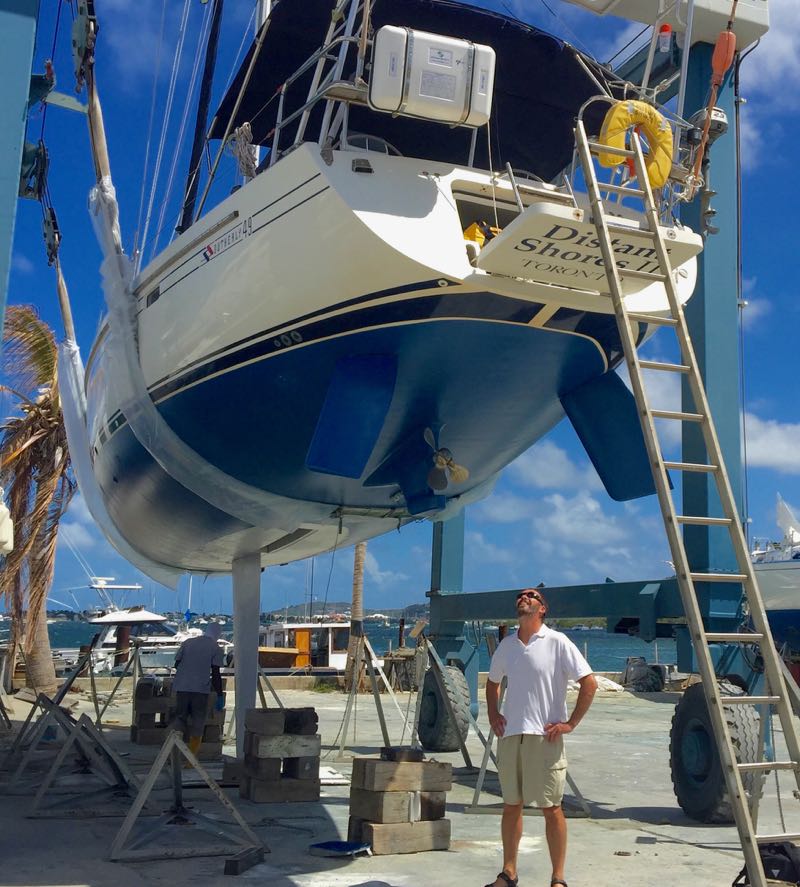
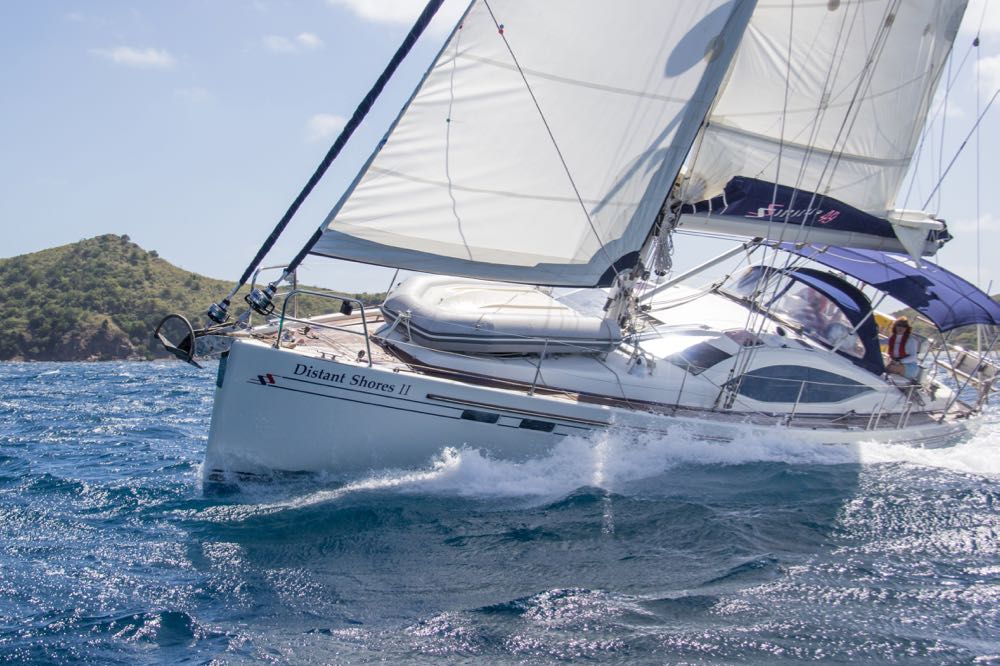
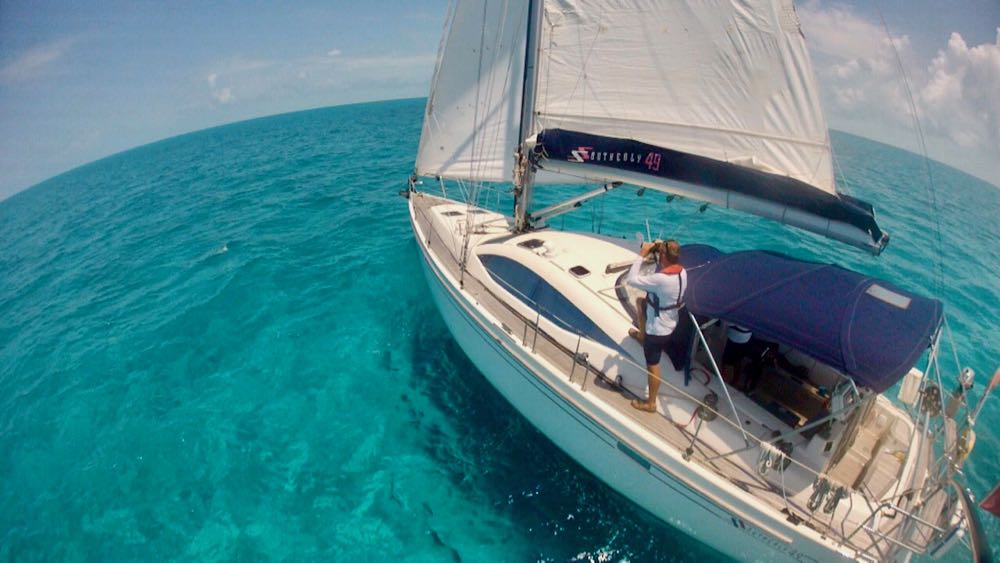
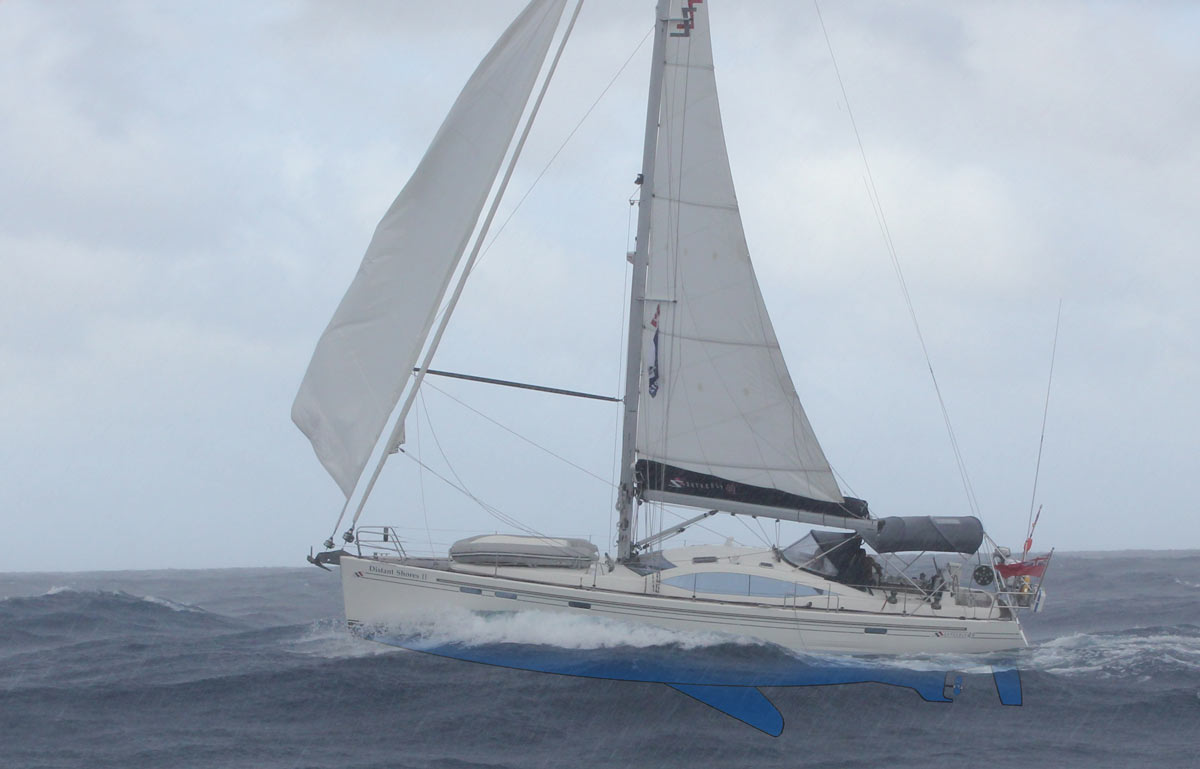
If you are considering buying a swing-keel yacht, please contact us for more information on the new Distant Shores III. She will have a swing keel just like Distant Shores and Distant Shores II and, based on our experience, she will be a great boat for a circumnavigation! We are currently working with a design team to develop this new model - to be launched later this year!
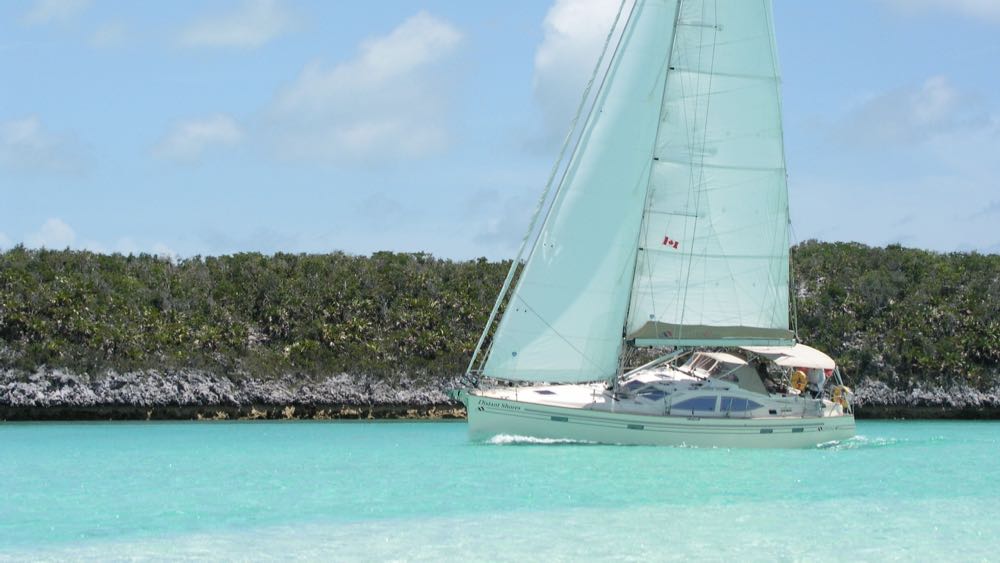
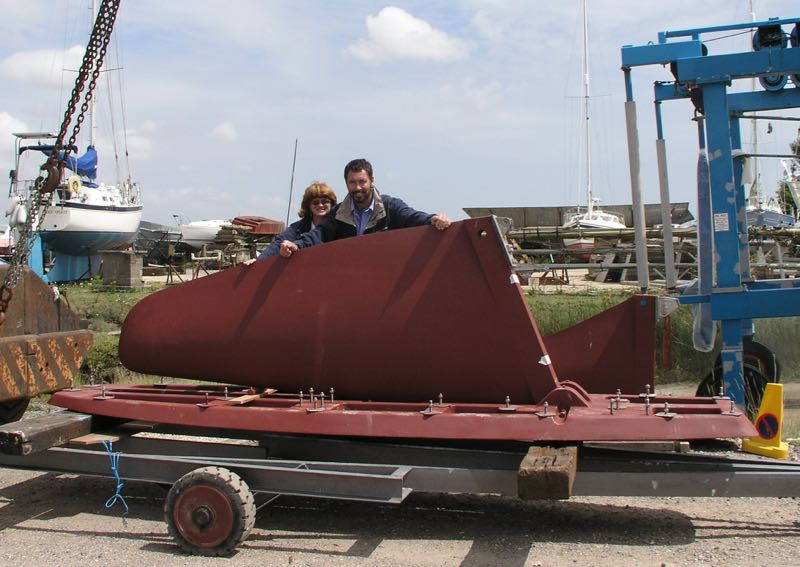
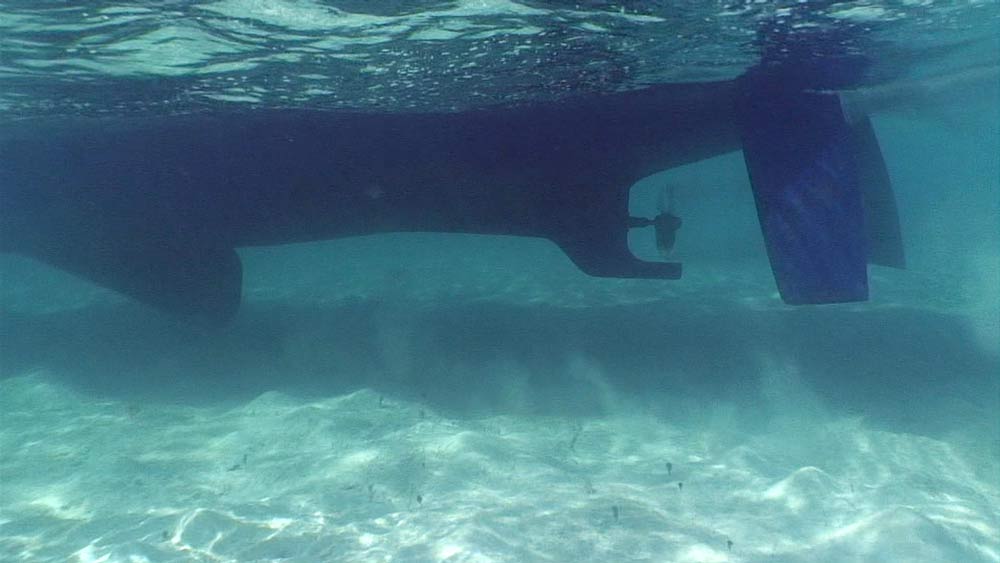
We're currently developing a new model of swinging keel shallow draft monohull. Distant Shores III be 48 feet long with a draft around 3' with the keel up. If you are in the market for a similar sailboat and would like more information please email us.
In an upcoming blog I will discuss how to sail a swing-keel yacht in heavy weather conditions…
Sailing Upwind
We always put the keel all the way down when working to windward. Our Southerly 49 draws 10' 3" (3.13m) with the keel down - an extremely deep aerofoil keel. Since the swing keel is also deeper than a conventional keel, it performs well upwind. The design doesn't carry as much weight deep down so the boats aren't as light or stiff as a racing boat, but they do well compared to a standard cruising boat with a moderate keel and offer many advantages to the cruising sailor. As you can see in the photo below, Southerly 49 keel at 10' 3" (3.13m) is a REALLY deep keel!
Aerofoil Keel Shape
Some centreboard boats have a flat board for a keel but the swing keels on the two Southerlys we've owned are both airfoil shaped and perform well upwind. I asked world-renowned yacht designer Rob Humphreys how important it was to have an aerofoil shaped keel. He said, "It’s vital, and not just for upwind performance. A well profiled aerofoil section keel optimizes the lift-drag ratio and widens the stall angle."
Sailing in Shallow Water
Whenever we are sailing in shallow water and there is a chance we might touch the bottom, we look over the chart and raise the keel to a comfortable depth. For example, when crossing the shallow Caicos Bank (photo below) we raise the keel halfway so we draw just 6-7 feet. The boat will still sail well, but she will not point as closely upwind. You can see we are close reaching. It is great to have this ability when exploring.
Broaching
Lifting the keel can reduce or eliminate the risk of the yacht broaching. According to cruising guru Jimmy Cornell, who owns a Garcia Exploration 45, "continuing to lift (the keel) up to the point where the board is fully retracted, is a great advantage as the risk of broaching is virtually eliminated. The absence of a keel to act as a pivot in a potential broaching situation means that the boat does not tend to round up when, in a similar situation, a keeled boat would do just that. It is a feature that I have blessed on many occasions and that has allowed me to continue keeping the spinnaker up longer than I would have done otherwise."Ocean Sailing Downwind
Before we sailed a Southerly Yacht across the ocean (we've now done it 5 times), I wondered what it would be like on a boat with a swing keel. Talking with other sailors who owned shallow-draft swing-keel yachts, I realized there were more options for sailing efficiently if you have a lifting keel. Swinging the keel up to raise it means you have actually moved the centre of lateral resistance backwards. It's possible to use this to your advantage when sailing downwind. Normally the yacht designer has carefully calculated the best position to mount a fixed keel. For a yacht with a swing keel, the design is done to optimize performance with the keel all the way down. When we swing the keel partially up, the centre of effort moves aft as you can see in the diagram below. We use this to improve performance when sailing downwind plus it reduces helm effort. It is similar to sailing a dinghy. With the keel most 70 percent raised, we have modified the bottom profile so the boat is more like an arrow. In this position the boat loves to sail downwind!
Distant Shores III
If you are considering buying a swing-keel yacht, please contact us for more information on the new Distant Shores III. She will have a swing keel just like Distant Shores and Distant Shores II and, based on our experience, she will be a great boat for a circumnavigation! We are currently working with a design team to develop this new model - to be launched later this year!
Swing Keel FAQ

Can you sail with the keel up?
Yes. The boat is safe to sail with the keel in any position including raised all the way up. Naturally the boat makes a lot of leeway when going to windward with the keel completely retracted, but she only heels a few more degrees. To understand this you can look at the image below of the keel for our Southerly 49 before it was installed during the build. The keel assembly consists of the massive grounding plate (weight 3180 kilos) plus the swinging keel at 2050 kilos. When you swing the keel up the centre of gravity does raise but not by enough to effect the safety or heeling by very much since so much of the ballast is in the grounding plate. In the picture above we have the keel of our Southerly 42 almost all the way up sailing the shallows of the Bahamas. We are drawing about 4.5 feet instead of our usual 9 feet (2.72m), the deepest draft of the Southerly 42. We are beating upwind and, despite making more leeway than usual, she still makes progress upwind.
What happens if you run aground?
The keel is designed to swing up into the hull when raised. Since it pivots on its front bearing in normal operation there is no damage if you hit something. Of course we try not to run aground, especially when moving at speed. The lifting pennant goes slack and the boat slows down. This is unlike a "vertically-lifting" centreboard which can be damaged by hitting something as the board jams in its case.
Does the board rattle?
We have never heard the keel move while sailing either of our Southerlys. We do not call it a centreboard since the weight and profile make it more like a regular keel. The swinging keel part of the assembly weighs 2050 kilos (4400 pounds) on the Southerly 49 which is about the same as a BMW 740 automobile! I don't think it could rattle. When we drop the keel down all the way it makes a thump as it comes to rest in the stops in the massive grounding plate.Does the keel require maintenance?
Yes. The keel lifting mechanism is a system and as such has a maintenance schedule. Once a year we check the hydraulic level, and every five years we replace the pennant that lifts the keel.Are you considering a Swing-Keel Sailboat?
We're currently developing a new model of swinging keel shallow draft monohull. Distant Shores III be 48 feet long with a draft around 3' with the keel up. If you are in the market for a similar sailboat and would like more information please email us.
In an upcoming blog I will discuss how to sail a swing-keel yacht in heavy weather conditions…
Pogo 50 - Lifting Keel - Full-On Performance
20/05/16 12:39
If you want to cruise, but cruise FAST... read on!
I got a chance to sail on a Pogo 50 last week in the Anguilla Regatta. For the first day of the regatta there was lots of wind, and we photographed the race from the press boat. On the second day I went out aboard the Pogo 50 for the race. Thanks very much for having me aboard guys!!
In case you haven't heard of Pogo, they are a French Boat builder (not a child's toy :-) specializing in very high performance monohulls. For years they have built Mini-Transat boats, 6.5 meters long (20 feet) and then grown to 30 and 40 footers. Always high-performance! But now they have branched a little more toward cruising with the new Pogo 50.
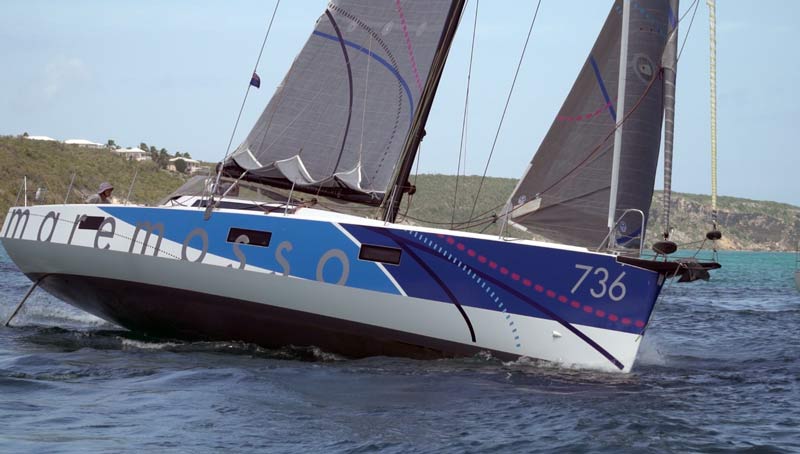
A Pogo 50 is still very much the high performance craft, but set up for cruising. Appropriately Pogo 50 Maremosso (which we met in Anguilla) was on an Atlantic cruise, and just entered the regatta for fun with their 4 crew.
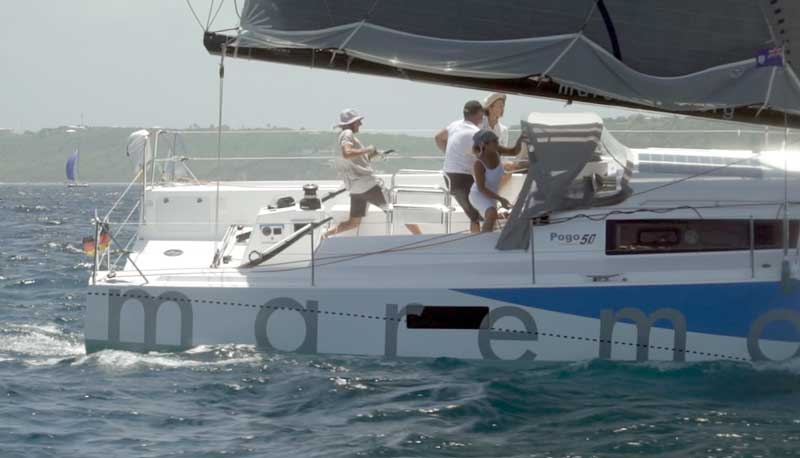
Swing-Keel
Did I mention the Pogo 50 is a swing-keel boat like ours (well… somewhat like ours)
Comparing our Southerly 49 to the Pogo 50 they are surprisingly similar in a number of respects…
Both the Pogo and Southerly can raise their keels for shallow water. The Pogo's draft with the keel down is just a foot more than ours at 11'5. Raising the keel for shallow water our Southerly draws just 3 feet, the Pogo less than 5. The difference here is she keeps much of her ballast in the bottom of the swinging 3 ton keel. We have a 3 ton plate in the hull which we can sit on when we have swung up our 2-ton keel and are beached. The Pogo must not be grounded like this I think or would risk damage as the keel is external even when swung up. (Image from YBW.COM) Both the Pogo and Southerly also have twin rudders.
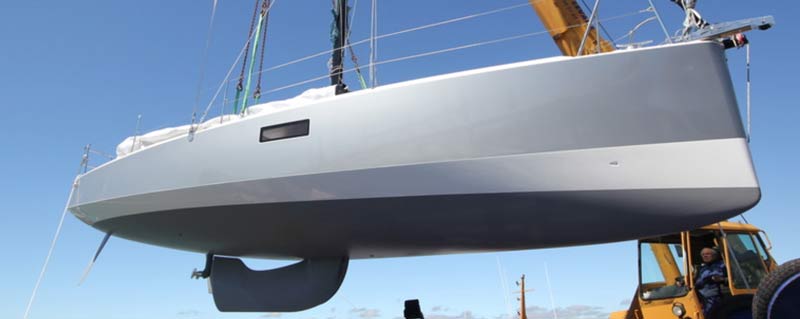
Pogo mast is 6 feet taller than our Southerly. She has quite a bit more sail area in the main however, with the high performance "fat head" sail configuration.
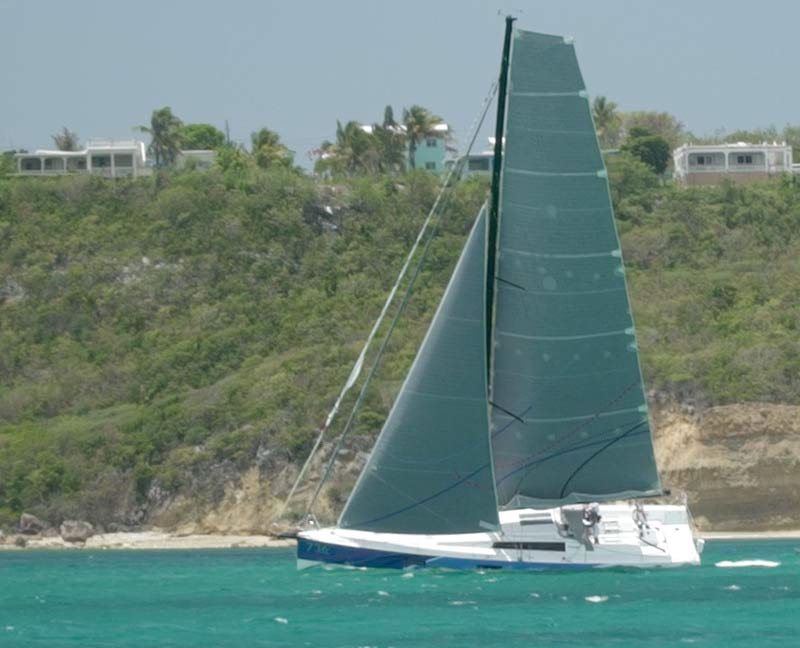
Even the interior layout is similar with the main cabin forward and two aft cabins. The biggest difference is the displacement. The Southerly 49 is nearly twice as heavy!
Inside they have simplified to keep it light, but do have a workable cruising interior. Here in the well-organized nav station, co-owner Guido describes their successful Atlantic ARC crossing (finished 17th).
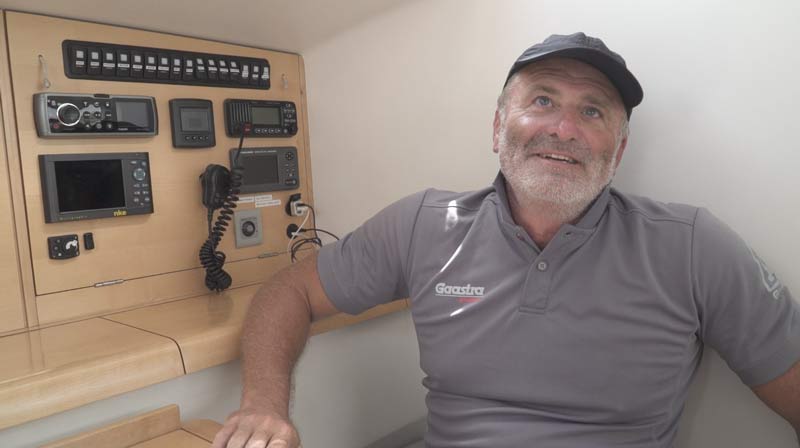
The interior (shot here from the Designer Finot-Conq website) is quite light and airy, and light-weight as well.
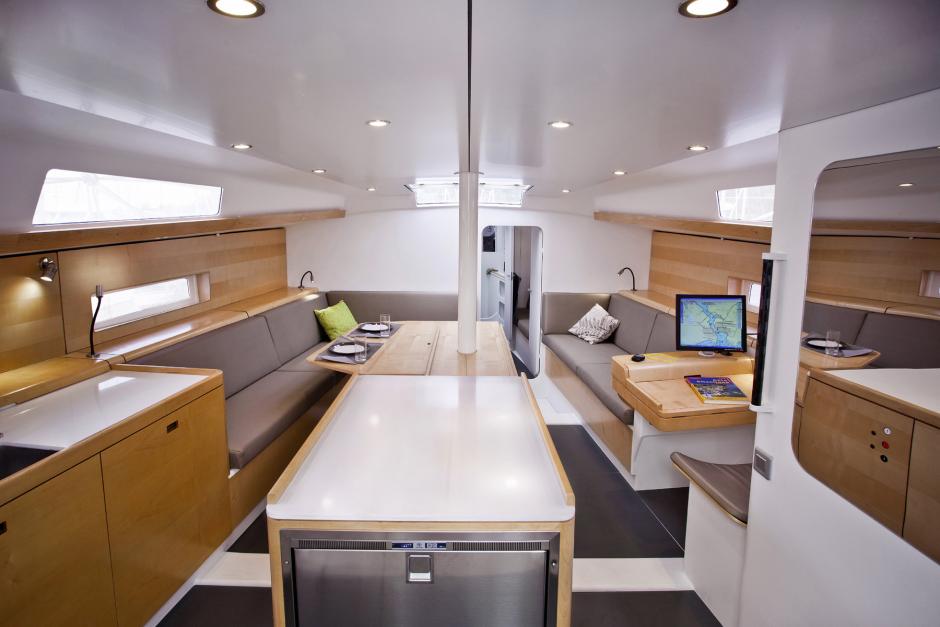
It was unfortunate that we had very light winds the second day of the regatta when I was racing aboard Maremosso. I had watched her roaring around the course the previous day, only to find light flukey winds for my day on board. Nevertheless it was obvious that this is a VERY fast, fun and responsive boat to sail. When even the slightest puff stirred the water we zipped along, but the crew was frustrated they couldn't really show her stuff!
Check out this video on Shallow Water Piloting
How to Read the Colour of the Water
12/06/14 07:56
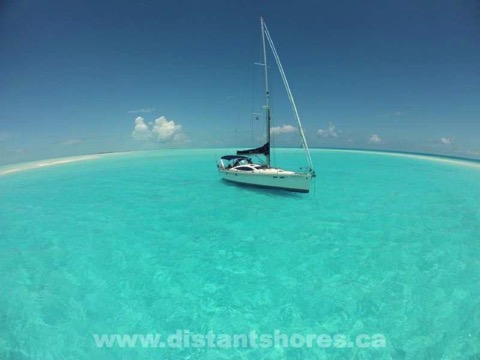
How deep is the water in the picture above? Could you anchor here?
If you want to safely cruise and enjoy the Bahamas or other shallow tropical destinations it is important to learn to read the depth by the colour of the water.
This picture is taken near White Cay south of George Town in the Bahamas. The light turquoise makes it look like a shallow swimming pool, and you can see that the bottom is all white sand. The blue colour of the water means that the light is travelling through enough water to change the light from clear to this blue colour.
The pale blue above means a bit more than 2 meters (6.6 feet) of water for us to see that level of “blue-ness”. So you would need a shoal draft boat to go in here.
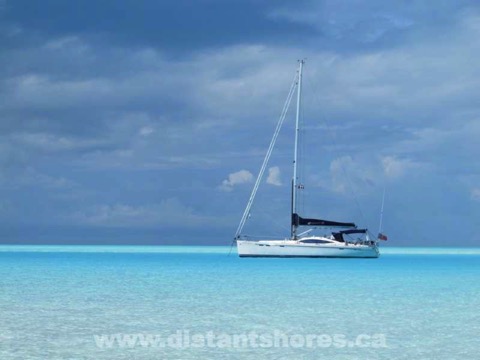
Here you can see the shallow water in the foreground (and far background) is less than 1/2 meter deep by the very pale blue-ness and to the right of the photo behind Distant Shores II is dry sand, therefore yellow. We are anchored in 2.5 meters.
Using the water colour to judge depth takes a bit of practice, and needs good light but is well worth the effort!
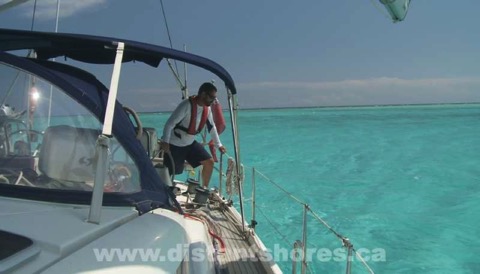
Keeping a close lookout using quality polarized sunglasses is important. If you are unsure if your glasses are polarized, you can tilt your head to see if the image changes. Looking at clouds in a blue sky you can see the sky get a darker blue. If you have an LCD display handy you can see if the image darkens when you tilt your head - then you have polarized glasses.
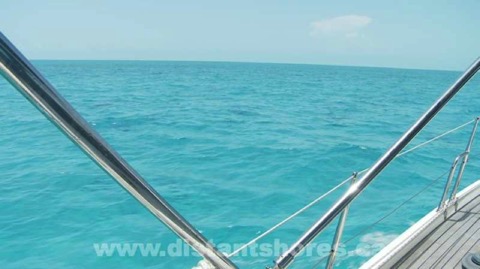
Here is a view with high sun through normal lenses... and below of the same view with polarized glasses.
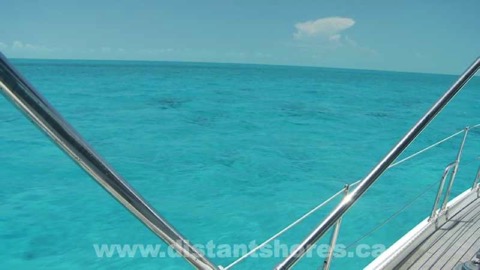
In this view you can see the water is quite a bit deeper. It is actually 4 meters - 13 feet deep and you can see a few small isolated rocks or small coral patches on the bottom. The patches are also deep so it is safe to navigate over them and you don’t need to dodge each one. If rocks are closer to the surface you can see them as sharper and darker colours.
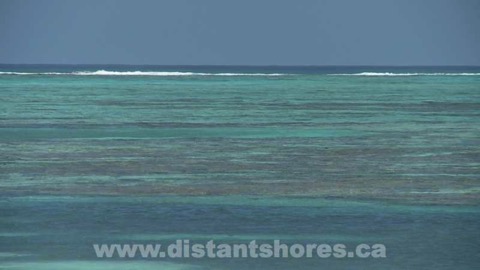
Here is a shallow coral beachfront (in the Turks & Caicos of Provo). This is all a “no-go” area since the bottom is rocky reef. The water over the reef patches looks brown, and is less than 1 meter deep. Anytime the water has that brown look is too shallow - even for a dinghy!
Below is an example of the water at 2 meters deep. We are approaching Hog Cay Cut in the Southern Exumas. Ahead you can see the cut as we leave the banks and approach George Town, Great Exuma. Note that a little further ahead you can see some slightly lighter colour water where it shallows to just 1.5 meters. Hog Cay cut is a tricky passage, and if you draw more than 1.5 meters is not recommended. There are spots with just 1 meter of water depth so most boats need to use a high or middle tide to get the extra water to make this passage safely. We are coming through on half tide and indeed find just 1.5 meters of water.
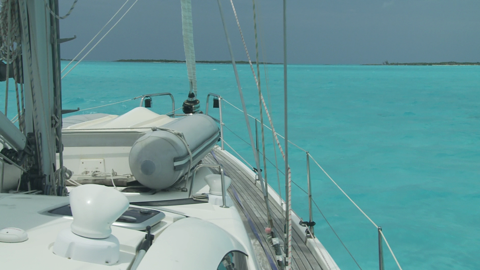
Finally here is a nice shot of the anchorage in George Town off Stocking Island.
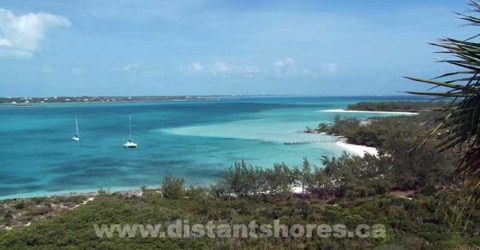
The water is less than 1 meter deep in the shallow bank in the centre of the photo. The main anchorage is mainly 3-4 meters deep and you can see grassy patches where it might be a little shallower. Anchor in the sandy bits for good holding and to enjoy your shallow water paradise!
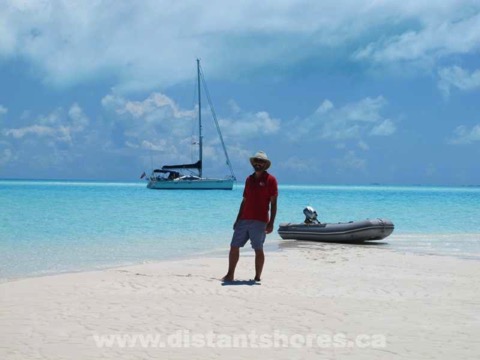
For more information on shallow water piloting check out “Cruising the Bahamas”, a one-hour video available on DVD and download as well as in the Bahamas/Caribbean Gift Pack of Distant Shores DVDs. All good resources for planning your upcoming cruise.
You Might Also Like the following...
Shallow Water Piloting
Tuning the Rig
About the Southerly 49
Top 10 Canal Journeys
Shallow Water Piloting
10/05/14 11:08
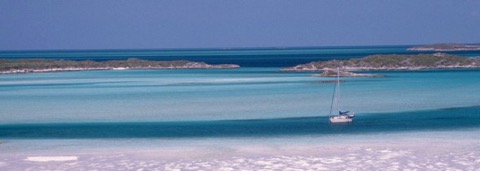
Ahhh Bahamas. Could this be the most beautiful water in the world?? Tough to judge for the whole world, but for many people the Bahamas are the best! And for American and Canadian sailors on the East Coast the Bahamas are the achievable paradise.
But beautiful as they are, the same shallow seas (Bahamas means shallow seas in Spanish - baja mar) can be a concern for sailors new to the practice of shallow water piloting. And its not just for shoal draft sailboats! Even with our old non-shoal draft sailboat with 6 feet draft we used these techniques and enjoyed shallow draft cruising grounds.
Sheryl and I have cruised these islands many times over the past 25 years and spent altogether 14 months cruising the shallow seas of the Bahamas.
Navigation has changed here with the advent of pinpoint accurate GPS and plotters but most of the techniques for safely navigating here have not changed. There are few aids to navigation in the Bahamas. Sand bars shift and reef grow.
10 Navigation Tips for Successful Shallow Water Bahamas Piloting
- Time your passage. It is easiest to judge water depth with the sun over your shoulder. High sun works best - 930 or 10 until 3pm or 3:30 will be best. Try not to come straight into the sun especially when it is lower on the horizon. Do not navigate at night! Rising tide means you can get off again if you get stuck.
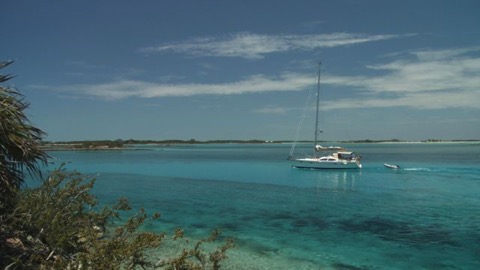
- Do not rely exclusively on waypoints. Cruising Guides have waypoints and they are useful but these are not designed to be used alone. Keep a lookout as well even when running point to point. For new places or routes we haven’t tried, Sheryl and I will check both our charts plus cruising guides for additional information when planning a trip.
- Know your boat’s draft and tolerance to running aground. Can you afford to run aground? If you have exposed rudders or propellors be sure not to run aground. What is the calibrated offset of your depth sounder? Is the offset calibrated to the bottom of keel or to the water surface?
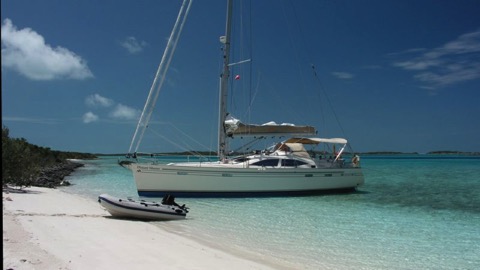
- Wear polarized sunglasses. They cut the glare on the surface of the water so that you can see down into the water much better when wearing polarized glasses.
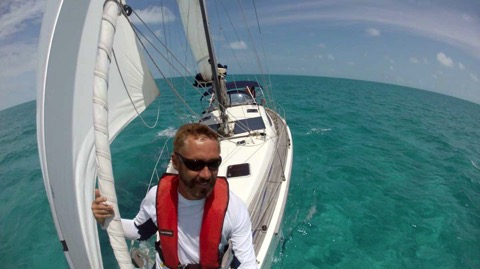
- Keep a good watch. Height helps - have a lookout standing on the cabin top or other high point. Do not look through windows or cockpit enclosures. Keep a sharp lookout. Post a lookout at the bow. Do not rely completely on Electronics.
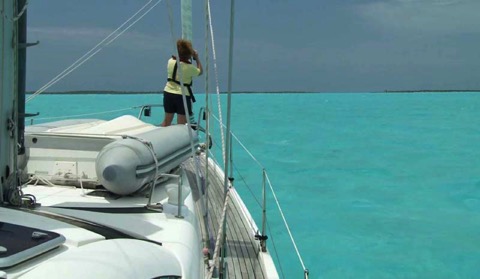
- Slow down or stop when unsure.
- Learn to judge the depth by the water-colour. Deep sapphire blue to swimming pool blue to pale yellow is all sand. Deep green or gray-black will be deeper water of 3-5 meters over grass or reef. Brown water will be quite shallow water over reef or rock - less than 1 meters. Judge depth over sand from sandy colour (less than 0.5 meter - 2 feet) very pale light blue (1 meter) to deep blue. (I will go into this in more depth in my next Tech Blog, “How to Read the Colour of the Water” since it is an important skill for skippers to develop to ensure a safe and happy cruise.) .
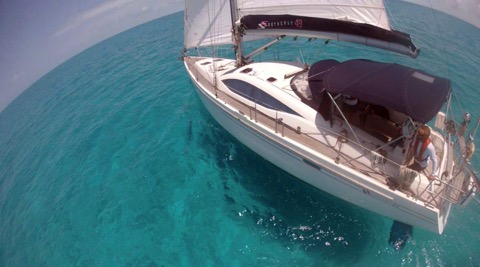
- Practice with your depth sounder. Judge the depth ahead (for example, picking a shallower sandy patch) and confirm your estimation as you pass over this patch. Explore ahead in the dinghy and confirm depths with a lead-line.
- Try out a Lead-Line. On our first trip to the Bahamas in 1989 friends gave us a lead-line neatly designed for our boat (which drew 6 feet). It was a 20 foot piece of thin cord and had ribbons tied every 2 feet with a fishing sinker on the end. The ribbons at 2,4 & 6 feet were red indicating depths we couldn't go. 8,10 & 12 were yellow and 14,16 & 18 indicated we could easily anchor here. Great for scouting in the dinghy or for checking depth off the stern...
- Be careful in cloudy conditions. The small trade-wind clouds common to the (otherwise) perfect sailing day in the Bahamas can cast a shadow on the water that look just like a black reef patch. The clue is to carefully watch the bearing - if the bearing changes then it’s a cloud. If you are unsure, head around it. When you get closer it’s easier to see if it’s really a reef. Not all clouds pose a problem. Soft clouds or on a high-cloud dull day it is still relatively easy to judge water colour.
Here is a video on the first time we beached our Southerly 42 in the Bahamas
We love the Bahamas and enjoy the challenge of piloting in the amazing blue waters here. A little preparation and practice will allow you to safely navigate this wonderful cruising ground.
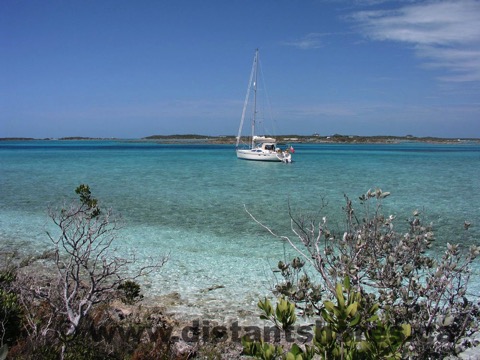

Join our email list and get hints, technical articles and tips plus videos to help you achieve your cruising dreams.
- FREE 1/2 hour video on cruising the Exuma Islands in the Bahamas
- Technical Blog shows you how to deal with issues facing the cruising sailor
- Destination information from some of the world's best cruising areas
- Special discounts and promotions
Top 10 Canal Journeys
16/11/13 08:50
French Canals - We spent 10 weeks on this trip - here crossing the Loire River
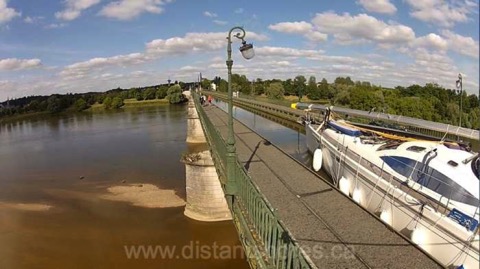
If you dream of exploring foreign countries by water, then the inland waterways and canals are a great way to see the inside of the country. I have just finished editing the last episode of Season 9 Distant Shores (here on Vimeo) - all about travelling on canals and waterways - and thought I could try to summarize and compare these voyages. Over 24 years we have made journeys on a dozen different canal systems. Here are our favourites. Honestly I did try to put them in order but it was too difficult. They were all fun!
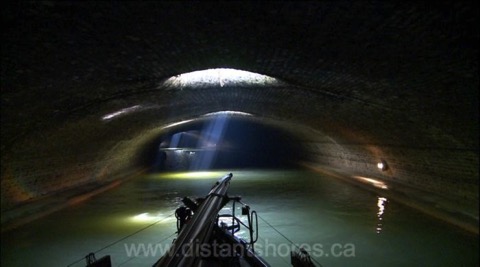 French Canals
French Canals
Right across France by boat!! There are numerous routes but all require the mast down as the small canals have clearances of just 3.5 meters. It is a modern route up the Seine to Paris though, so if you just want to visit Paris clearances are higher - 5.5 meters to enter into the excellent Arsenal Basin marina.
We did the whole trip across France in 10 weeks but this included 10 days in Paris, and many other stops. If you plan to take your own boat it should probably be less than 1.7 meters to enjoy the trip. You can also rent boats at different areas along the way. Here are links to blogs on preparing for the Canals, taking the mast down, fendering, and general recommendations.
USA - ICW
The US Intra-Coastal Waterway (or ICW) will always have a warm spot in our hearts as it was part of our first big cruise - leaving Canada and heading south to the Bahamas back in 1989. The whole 900-odd miles we travelled from Norfolk to Ft Lauderdale took us roughly 5 weeks with many great stops along the way including charming towns, nice anchorages, friendly folks and some challenging navigation. Nowadays it has shoaled up somewhat in certain areas but I think is still a fun trip. You have a height clearance of 64 feet so it's a "mast-up" route for most boats.
Scottish Canals
The Crinan & Caledonian Canals are also "mast-up" routes for most boats (27 meters clearance to transit the Caledonian), deep and well maintained. The Crinan is short and could be done in 6 hours but we divided it in half staying the night along the way, and at the end. The Caledonian is much longer allowing you to cross Scotland and go through Loch Ness en route to Inverness. Pubs and a few cute villages en route plus spectacular scenery!
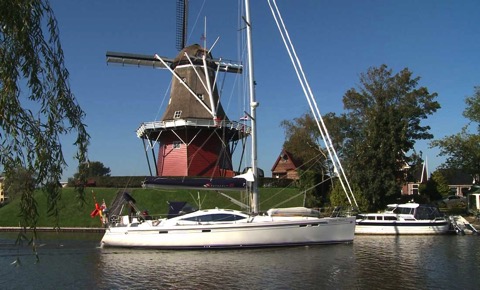 Dutch Canals - Standing Mast Route
Dutch Canals - Standing Mast Route
We were surprised by how lovely this trip was! It had been difficult to get good info on the Dutch Canals so perhaps we hadn’t understood just how charming the dutch towns were along the way. We started at the north in the Lauwersmeer, and visited Dokkum, Leeuwarden and Lemmer before crossing the IJsselmeer to Enkhuisen, Hoorn and Amsterdam. All these stops were AMAZING... historic, friendly and neat as a pin. (here’s our blog on the Dutch Canals)
UK Narrowboat Canals
Quirky and charming, the narrow canal system in the UK is one of the oldest systems we travelled. The canals are so small you can only do it in the special narrowboats (unless you travel by canoe!) The beam is just 7 feet (including fenders) so no normal cruising boats can do this system. But narrowboats are readily available for hire and it’s a fun way to see the countryside. Chugging along a waterway that’s hardly bigger than a ditch... there are pub lunches and evenings tied to the shore in the middle of the country. It sometimes seems like you have gone back one or two hundred years. We only did 3 days on this system but could see returning to do another trip. Here’s the link to our program on Vimeo.
New York’s Erie Canal
This is a very useful short-cut from the Great Lakes to the route south. The Erie Canal is also quite fun, travelling through some lovely scenery and nice small US towns. They are actively encouraging boat traffic and some towns offer free/cheap dockage wifi etc. We recommend you add a day or two to the plan here to take advantage of this lovely route. It's not just a shortcut but a destination! At the end is the dramatically beautiful Hudson River and New York City.
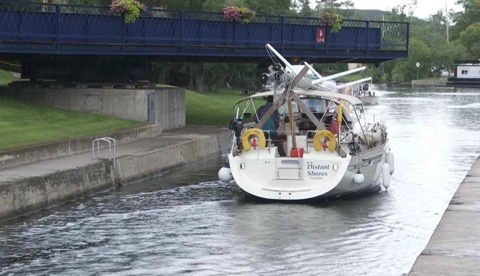 Canada’s Trent Severn
Canada’s Trent Severn
44 locks and 210 miles of rivers, lakes and waterway connect Lake Ontario to Georgian Bay. The Trent-Severn Waterway crosses a very pretty area on Ontario, Canada with vacation cottage lakes and tiny old Canadian towns. Water depths are 6 feet but over 5 feet will have some issues. Height is restricted to 22 feet so its "mast-down" for sailboats. We spent 7 days coming through to Lake Simcoe. If you don’t want to bring your own boat this is another nice opportunity to rent a houseboat. Highlights are the remarkable lift locks (which we filmed) and the nice cottage lakes. Best time is June-September.
Sweden’s Gota Canal
We spent more than a week crossing Sweden via the Gota Canal. We did it in September but would recommend it during the summer season. The middle section crosses lovely northern lakes with nice swimming in summer. There are some cute small towns and there was even an opportunity to moor up in the moat of a Castle!
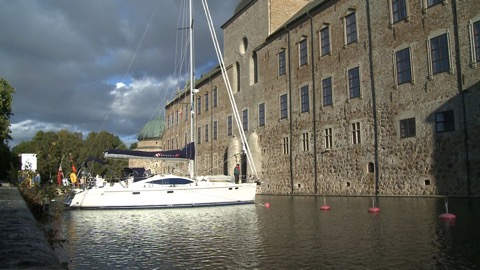
For More info check out all my blogs related to Canals
On DVD our shows on Canals were
Season 5 - Trent Severn
Season 6 - Erie Canal & ICW
Season 7 - Narrowboats, Kiel Canal, Gota Canal, Dutch Standing Mast
Season 8 - Scottish Crinan and Caledonian Canals
Season 9 - French Canals (5 episodes) and Great Canals Journeys
Plan your passages around the world with us aboard Distant Shores
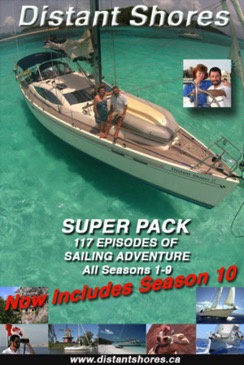
Order the Super Pack on DVD and get Season 1-10 Downloadable.
Order the Super Pack on Vimeo and we will send you the code for Season 10 as a bonus.

If you dream of exploring foreign countries by water, then the inland waterways and canals are a great way to see the inside of the country. I have just finished editing the last episode of Season 9 Distant Shores (here on Vimeo) - all about travelling on canals and waterways - and thought I could try to summarize and compare these voyages. Over 24 years we have made journeys on a dozen different canal systems. Here are our favourites. Honestly I did try to put them in order but it was too difficult. They were all fun!

Right across France by boat!! There are numerous routes but all require the mast down as the small canals have clearances of just 3.5 meters. It is a modern route up the Seine to Paris though, so if you just want to visit Paris clearances are higher - 5.5 meters to enter into the excellent Arsenal Basin marina.
We did the whole trip across France in 10 weeks but this included 10 days in Paris, and many other stops. If you plan to take your own boat it should probably be less than 1.7 meters to enjoy the trip. You can also rent boats at different areas along the way. Here are links to blogs on preparing for the Canals, taking the mast down, fendering, and general recommendations.
USA - ICW
The US Intra-Coastal Waterway (or ICW) will always have a warm spot in our hearts as it was part of our first big cruise - leaving Canada and heading south to the Bahamas back in 1989. The whole 900-odd miles we travelled from Norfolk to Ft Lauderdale took us roughly 5 weeks with many great stops along the way including charming towns, nice anchorages, friendly folks and some challenging navigation. Nowadays it has shoaled up somewhat in certain areas but I think is still a fun trip. You have a height clearance of 64 feet so it's a "mast-up" route for most boats.
Scottish Canals
The Crinan & Caledonian Canals are also "mast-up" routes for most boats (27 meters clearance to transit the Caledonian), deep and well maintained. The Crinan is short and could be done in 6 hours but we divided it in half staying the night along the way, and at the end. The Caledonian is much longer allowing you to cross Scotland and go through Loch Ness en route to Inverness. Pubs and a few cute villages en route plus spectacular scenery!

We were surprised by how lovely this trip was! It had been difficult to get good info on the Dutch Canals so perhaps we hadn’t understood just how charming the dutch towns were along the way. We started at the north in the Lauwersmeer, and visited Dokkum, Leeuwarden and Lemmer before crossing the IJsselmeer to Enkhuisen, Hoorn and Amsterdam. All these stops were AMAZING... historic, friendly and neat as a pin. (here’s our blog on the Dutch Canals)
UK Narrowboat Canals
Quirky and charming, the narrow canal system in the UK is one of the oldest systems we travelled. The canals are so small you can only do it in the special narrowboats (unless you travel by canoe!) The beam is just 7 feet (including fenders) so no normal cruising boats can do this system. But narrowboats are readily available for hire and it’s a fun way to see the countryside. Chugging along a waterway that’s hardly bigger than a ditch... there are pub lunches and evenings tied to the shore in the middle of the country. It sometimes seems like you have gone back one or two hundred years. We only did 3 days on this system but could see returning to do another trip. Here’s the link to our program on Vimeo.
New York’s Erie Canal
This is a very useful short-cut from the Great Lakes to the route south. The Erie Canal is also quite fun, travelling through some lovely scenery and nice small US towns. They are actively encouraging boat traffic and some towns offer free/cheap dockage wifi etc. We recommend you add a day or two to the plan here to take advantage of this lovely route. It's not just a shortcut but a destination! At the end is the dramatically beautiful Hudson River and New York City.

44 locks and 210 miles of rivers, lakes and waterway connect Lake Ontario to Georgian Bay. The Trent-Severn Waterway crosses a very pretty area on Ontario, Canada with vacation cottage lakes and tiny old Canadian towns. Water depths are 6 feet but over 5 feet will have some issues. Height is restricted to 22 feet so its "mast-down" for sailboats. We spent 7 days coming through to Lake Simcoe. If you don’t want to bring your own boat this is another nice opportunity to rent a houseboat. Highlights are the remarkable lift locks (which we filmed) and the nice cottage lakes. Best time is June-September.
Sweden’s Gota Canal
We spent more than a week crossing Sweden via the Gota Canal. We did it in September but would recommend it during the summer season. The middle section crosses lovely northern lakes with nice swimming in summer. There are some cute small towns and there was even an opportunity to moor up in the moat of a Castle!

For More info check out all my blogs related to Canals
On DVD our shows on Canals were
Season 5 - Trent Severn
Season 6 - Erie Canal & ICW
Season 7 - Narrowboats, Kiel Canal, Gota Canal, Dutch Standing Mast
Season 8 - Scottish Crinan and Caledonian Canals
Season 9 - French Canals (5 episodes) and Great Canals Journeys
Plan your passages around the world with us aboard Distant Shores

Order the Super Pack on DVD and get Season 1-10 Downloadable.
Order the Super Pack on Vimeo and we will send you the code for Season 10 as a bonus.
Canals - Recommendations
24/07/12 06:33
Well we finished the French Canals after a very successful trip lasting almost 10 weeks. It was something we had dreamed of doing for years. It was a great voyage and we had a blast! Coming into Paris on our own boat, visiting small french villages and tasting wines at the “caves”... If you are thinking of seeing France by canal there are a number of options. Chartering a houseboat/peniche is one option. Going aboard a larger Peniche as a passenger or bicycle tour is another. But this blog is about taking your own boat. Can you do it and will it be any fun?
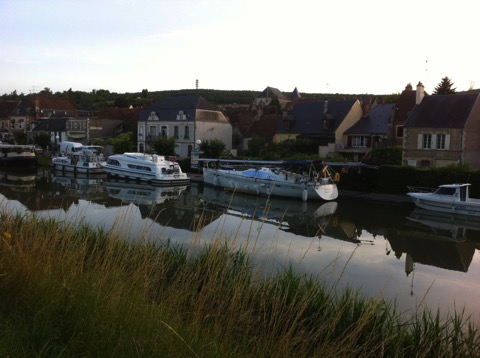
Suitable boats
Draft - We have seen a variety of craft in the canals but some were having less fun than others... If you have a boat that draws more than 1.8 meters than you should not even consider the trip. If your boat draws between 1.6 and 1.8 then you should be prepared to run a ground a fair bit. Boats drawing less than 1.6 will be safe. we draw less than 1 meter but swing the keel down to 1.6 for most of the trip as a safety valve. We very rarely touched bottom when staying in the proper channel, but when passing other craft we had to more to the side of the channel and were glad we drew less than 1.8.
Beam - Our beam is 4.2 meters and the limit is 5 meters. But lock chambers are just 5 meters wide so your beam must include the width of your fenders. For us that meant we had less than 20cm clearance on each side as we came in to the locks. Thats less than a foot. So for boats more than 4.5 meters wide you will need a good fender strategy that isn’t very wide to fit in the locks. Our fender system worked very will. I highly recommend you think carefully on the fender system. With a good strategy we never worried about the narrow locks and bridges. If we jostled the lock wall our boards just bounced us safely away. And once settled in the lock chamber our width meant we almost didn’t need to tie up in the chamber - we were a tight fit and just sat there (same as the big peniches)
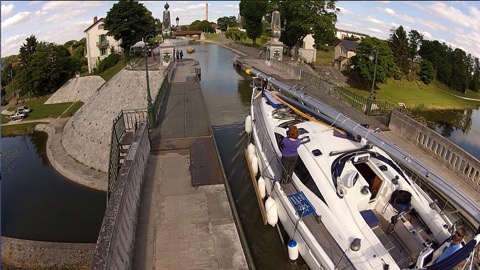
Fender Board
I believe our large fender board was the secret to a stress free passage (nearly stress free:-) and here are few hints.
Keep it low for the many locks that raise the boat up to there is just a few inches of wall remaining. Our boats was 12 inches tall and could be hung right down so it nearly drags in the water. Bevel the edges and front so it doesn’t get caught on the walls. Make sure the lines attached do not go on the outside or they will wear through. Tie a line to the front of the board that runs forward so the board won’t be swung back when you rub along the walls. We bought 8 more fender before the trip and it was cheap insurance. No scratches after the trip!
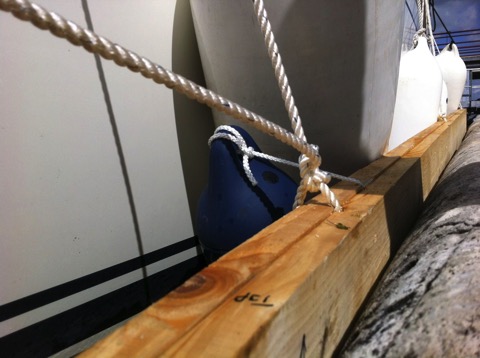
Bow thruster
Having a bow thruster was a great advantage.
We used it quite a lot and it again reduced stress. We even used it in the locks sometimes to centre the boat when currents swung us around. Take a spare fuse for the thruster too.
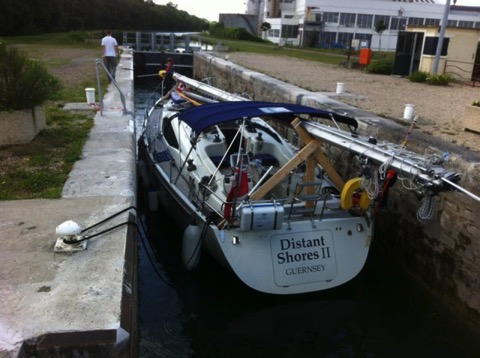
Height
The canals have different restrictions on height. For the Canal Briare/ Loire/ Centre that we took the restriction is 3.5 meters of “air Draft” If you don’t know your exact height you must figure it out precisely before starting. We measured our height with the mast on deck at 3.1 meters so had plenty of clearance. If you are 3.4 or greater you might need to take something down?
Carrying the Mast?
We carried our mast because it is too long to be transported by road in France. However if your mast is less than 18 meters long it can be trucked to meet you. Then the boat is easier to manage, shorter and tidier. Worth a thought!
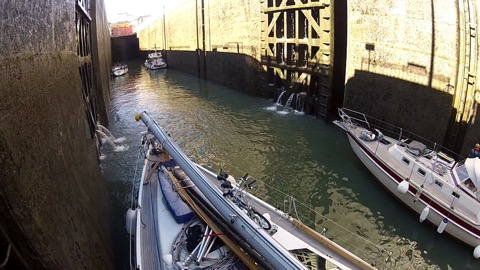
Shortcut?
Some people look at the route from the North Sea down to the Med as a shortcut. If you have a powerboat that might not be up to crossing the Bay of Biscay, then this is a reasonable idea. But for a well-found sailboat that could do the passage around then it is not really much of a shortcut since you have to deal with the mast and the locks take quite a while.
But , if like us, you are interested in seeing France from the deck of your own boat, the French Canals are an unforgettable adventure and wonderful way to see this romantic and beautiful nation.

Suitable boats
Draft - We have seen a variety of craft in the canals but some were having less fun than others... If you have a boat that draws more than 1.8 meters than you should not even consider the trip. If your boat draws between 1.6 and 1.8 then you should be prepared to run a ground a fair bit. Boats drawing less than 1.6 will be safe. we draw less than 1 meter but swing the keel down to 1.6 for most of the trip as a safety valve. We very rarely touched bottom when staying in the proper channel, but when passing other craft we had to more to the side of the channel and were glad we drew less than 1.8.
Beam - Our beam is 4.2 meters and the limit is 5 meters. But lock chambers are just 5 meters wide so your beam must include the width of your fenders. For us that meant we had less than 20cm clearance on each side as we came in to the locks. Thats less than a foot. So for boats more than 4.5 meters wide you will need a good fender strategy that isn’t very wide to fit in the locks. Our fender system worked very will. I highly recommend you think carefully on the fender system. With a good strategy we never worried about the narrow locks and bridges. If we jostled the lock wall our boards just bounced us safely away. And once settled in the lock chamber our width meant we almost didn’t need to tie up in the chamber - we were a tight fit and just sat there (same as the big peniches)

Fender Board
I believe our large fender board was the secret to a stress free passage (nearly stress free:-) and here are few hints.
Keep it low for the many locks that raise the boat up to there is just a few inches of wall remaining. Our boats was 12 inches tall and could be hung right down so it nearly drags in the water. Bevel the edges and front so it doesn’t get caught on the walls. Make sure the lines attached do not go on the outside or they will wear through. Tie a line to the front of the board that runs forward so the board won’t be swung back when you rub along the walls. We bought 8 more fender before the trip and it was cheap insurance. No scratches after the trip!

Bow thruster
Having a bow thruster was a great advantage.
We used it quite a lot and it again reduced stress. We even used it in the locks sometimes to centre the boat when currents swung us around. Take a spare fuse for the thruster too.

Height
The canals have different restrictions on height. For the Canal Briare/ Loire/ Centre that we took the restriction is 3.5 meters of “air Draft” If you don’t know your exact height you must figure it out precisely before starting. We measured our height with the mast on deck at 3.1 meters so had plenty of clearance. If you are 3.4 or greater you might need to take something down?
Carrying the Mast?
We carried our mast because it is too long to be transported by road in France. However if your mast is less than 18 meters long it can be trucked to meet you. Then the boat is easier to manage, shorter and tidier. Worth a thought!

Shortcut?
Some people look at the route from the North Sea down to the Med as a shortcut. If you have a powerboat that might not be up to crossing the Bay of Biscay, then this is a reasonable idea. But for a well-found sailboat that could do the passage around then it is not really much of a shortcut since you have to deal with the mast and the locks take quite a while.
But , if like us, you are interested in seeing France from the deck of your own boat, the French Canals are an unforgettable adventure and wonderful way to see this romantic and beautiful nation.
Canals - Fender strategies
16/06/12 10:53
The French Canals are a destination we have wanted to cruise for many years. Five thousand miles of canals criss-cross the country and also connect to Belgium, Holland, Germany and beyond. Altogether you have thousands of miles to explore and many years worth of cruising in the European waterways. For us we have planned a 3 month excursion crossing France - a leisurely journey with plenty of time to stop and sample the wines, cheeses and pretty french villages.
Canal System
Some of the canals we will travel on were built 400 years ago, and most were designed for barges up to 5.2 meters wide by 1.8 meters deep and 38 meters long. The barges are big and square and just fit into the locks - no room for niceties like fenders. For the modern yacht that doesn’t want to scratch her topsides we will need a system to work safely through the locks. Distant Shores II is 4.2 meters wide so we will have just 0.4 meter on either side including fenders. If your boat is square and made of steel then you may not need any of this!!
Design Criteria
- entering the lock - approaching a lock we will be moving slowly and trying not to hit either side so we will need fenders that allow us to nudge the side of the lock and not slide up out of the way. Some people have used a huge rope hung like a belt around the wides point (generally the gunwales). We have opted for fender boards hung down outside the fenders to absorb friction of the walls and protect the fenders. We tie the board with a forward line as well so it won’t swing back if we scrape the wall moving in the lock.
- rising up or going down in the locks - going up in locks is usually rougher since the turbulence of the incoming water can push the boat around. Most sailboats have narrow bows and sterns so need to have some large fenders near the corners to protect against the bow or stern hitting the lock. The huge “tear-drop” fenders work well for this and also for powerboats wishing to protect their flared bows.
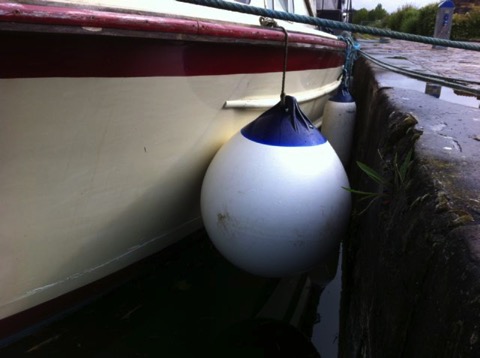
- low lock walls - some locks tend to fill up quite high so there isn’t much wall left at the top of the lift. In this case there might be just a few inches left of lock wall and fenders may all pop out. So it is important to be ready with some protection down near the water line.
Here is our current version of the system (Version 3.3?)
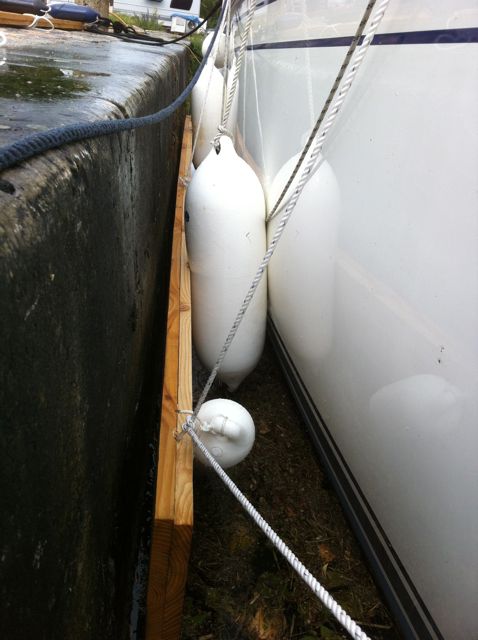
Fender Board Notes
In the upper picture you can see the support line holding the board up and the line going forward to stop is swinging back when we rub the lock wall on the way on and out of the lock. Some people use this same system for holding a bunch of fenders. One line from the bow down to the bottom of the first fender and then running aft tethering each fender to they don’t swing back.
Fender boards will scrape along the rough lock walls. It is important that lines tying the boards must not be on the outside of the board or they will quickly chafe through. There are various solutions to this. I made our 2 inch thick board from 2 times 1inch boards. I drilled holes through the inner board for the lines and attached the outer board to that with screws and glue. There will be a considerable wearing down of the outer board by the time we are through the locks.
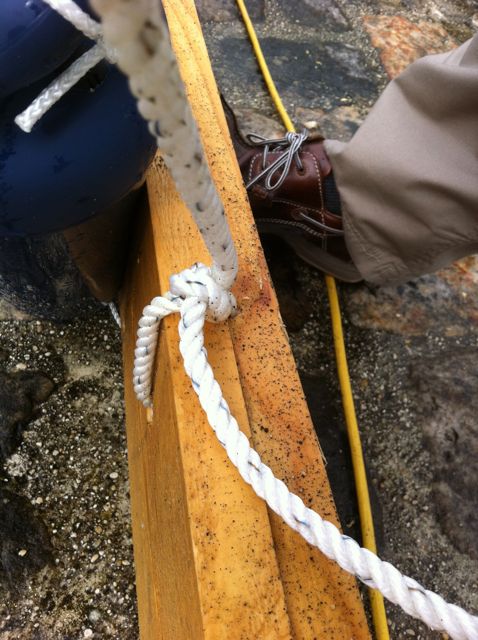
Canal System
Some of the canals we will travel on were built 400 years ago, and most were designed for barges up to 5.2 meters wide by 1.8 meters deep and 38 meters long. The barges are big and square and just fit into the locks - no room for niceties like fenders. For the modern yacht that doesn’t want to scratch her topsides we will need a system to work safely through the locks. Distant Shores II is 4.2 meters wide so we will have just 0.4 meter on either side including fenders. If your boat is square and made of steel then you may not need any of this!!
Design Criteria
- entering the lock - approaching a lock we will be moving slowly and trying not to hit either side so we will need fenders that allow us to nudge the side of the lock and not slide up out of the way. Some people have used a huge rope hung like a belt around the wides point (generally the gunwales). We have opted for fender boards hung down outside the fenders to absorb friction of the walls and protect the fenders. We tie the board with a forward line as well so it won’t swing back if we scrape the wall moving in the lock.
- rising up or going down in the locks - going up in locks is usually rougher since the turbulence of the incoming water can push the boat around. Most sailboats have narrow bows and sterns so need to have some large fenders near the corners to protect against the bow or stern hitting the lock. The huge “tear-drop” fenders work well for this and also for powerboats wishing to protect their flared bows.

- low lock walls - some locks tend to fill up quite high so there isn’t much wall left at the top of the lift. In this case there might be just a few inches left of lock wall and fenders may all pop out. So it is important to be ready with some protection down near the water line.
Here is our current version of the system (Version 3.3?)
- a 4 meter fender board (each side) that is a foot high (13 feet long X 12 inches high and 2 inches thick). Small fenders attached to the board as a backup in case the main fenders slide out. A forward line to keep it in place as we move along the lock wall.
- low “swimming” fender boards as a last defence against very low lock walls if the lock is overfilled and our fenders pop out
- large fenders at bow and stern to protect in the event of the bow or stern swinging in to the wall

Fender Board Notes
In the upper picture you can see the support line holding the board up and the line going forward to stop is swinging back when we rub the lock wall on the way on and out of the lock. Some people use this same system for holding a bunch of fenders. One line from the bow down to the bottom of the first fender and then running aft tethering each fender to they don’t swing back.
Fender boards will scrape along the rough lock walls. It is important that lines tying the boards must not be on the outside of the board or they will quickly chafe through. There are various solutions to this. I made our 2 inch thick board from 2 times 1inch boards. I drilled holes through the inner board for the lines and attached the outer board to that with screws and glue. There will be a considerable wearing down of the outer board by the time we are through the locks.

Preparing for Canals
08/05/12 02:58
Bonjour toutes mes amis
Sheryl and I are back on board Distant Shores II in England getting ready for the French Canals.
We have planned 3 months for this trip but have been dreaming about it for more than 15 years! It always sounded very romantic to cross France by boat, and when I learned you could go right into the centre of Paris, I knew we would do it someday. But back then we owned Two-Step and she is too deep to manage the canals at 6 feet. The Canal de Midi route has a maximum draft of around 1.5 meters and the various Paris/Med routes have a limit of 1.8 meters. Two-Step drew over 1.8 so would not be allowed in. Bummer! This was where we first started seriously considering a shallow draft boat! Now we are coming to finally tackle the canals - our draft is less than 1 meter!
Taking a Sailboat in the canals
First we must deal with the mast. There are not many canals that allow for sailboats to transit with the mast up. We did a few of these routes the past two years.
Gota Canal in Sweden (Season 7 - episode 10,11)
Kiel Canal to the Baltic in Germany (Season 7 - episode 6)
Dutch Staandemastroute - Standing Mast route through Holland (Season 7- episode 12)
Crinan Canal - Season 8 episode 3
Caledonian Canal - Season 8 episode 4
These canals all allow a sailboat with mast height less than 21 meters. But crossing France we must take the mast down.
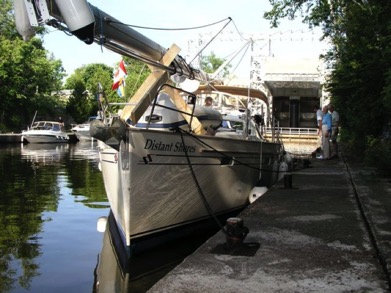 Mast on Deck?
Mast on Deck?
In the past we have done the Erie Canal in the USA and Canada’s Trent Severn Waterway carrying the mast on deck. French canals have a maximum “air draft” of less than 3.5 meters so we would have to carry the mast lower than we have in the past. The alternative in France is to use a mast service to transport the mast. It will be waiting when you arrive at the end. The advantage is not banging your head in it for the 2-3 months of canalling, plus not dealing with the “overhang” since the masts of most sailboats are longer than the hull.
Fendering - Protection
I am currently working on the fendering system. We normally use a fender board hung outside a pair of fenders to protect against rough lock walls. With this extended canal cruise I am adding even more fenders and plan 3 more fender boards so we have 2 each side. I will post again when we have this system set up finally.
Miscellaneous
Other considerations include preparing for a trip as a motorboat. So carry engine spares, lots of fuel and possibly jerry cans if you can’t get the boat to a fuel dock. Practice clearing the intake water filter since there will be more debris/grass/weed than normal. Carry extra impeller for the same reason.
Charts and guide books etc ... more in the next blog...
Sheryl and I are back on board Distant Shores II in England getting ready for the French Canals.
We have planned 3 months for this trip but have been dreaming about it for more than 15 years! It always sounded very romantic to cross France by boat, and when I learned you could go right into the centre of Paris, I knew we would do it someday. But back then we owned Two-Step and she is too deep to manage the canals at 6 feet. The Canal de Midi route has a maximum draft of around 1.5 meters and the various Paris/Med routes have a limit of 1.8 meters. Two-Step drew over 1.8 so would not be allowed in. Bummer! This was where we first started seriously considering a shallow draft boat! Now we are coming to finally tackle the canals - our draft is less than 1 meter!
Taking a Sailboat in the canals
First we must deal with the mast. There are not many canals that allow for sailboats to transit with the mast up. We did a few of these routes the past two years.
Gota Canal in Sweden (Season 7 - episode 10,11)
Kiel Canal to the Baltic in Germany (Season 7 - episode 6)
Dutch Staandemastroute - Standing Mast route through Holland (Season 7- episode 12)
Crinan Canal - Season 8 episode 3
Caledonian Canal - Season 8 episode 4
These canals all allow a sailboat with mast height less than 21 meters. But crossing France we must take the mast down.

In the past we have done the Erie Canal in the USA and Canada’s Trent Severn Waterway carrying the mast on deck. French canals have a maximum “air draft” of less than 3.5 meters so we would have to carry the mast lower than we have in the past. The alternative in France is to use a mast service to transport the mast. It will be waiting when you arrive at the end. The advantage is not banging your head in it for the 2-3 months of canalling, plus not dealing with the “overhang” since the masts of most sailboats are longer than the hull.
Fendering - Protection
I am currently working on the fendering system. We normally use a fender board hung outside a pair of fenders to protect against rough lock walls. With this extended canal cruise I am adding even more fenders and plan 3 more fender boards so we have 2 each side. I will post again when we have this system set up finally.
Miscellaneous
Other considerations include preparing for a trip as a motorboat. So carry engine spares, lots of fuel and possibly jerry cans if you can’t get the boat to a fuel dock. Practice clearing the intake water filter since there will be more debris/grass/weed than normal. Carry extra impeller for the same reason.
Charts and guide books etc ... more in the next blog...
Sailing a Bigger Boat
30/04/10 02:28
 We have had a few weeks of test sailing now. The spring here in south England has been lovely and we have been able to get out on a number of excursions. Although we are still getting the feel of the new boat - we have a number of observations on how she handles. It has been great to have this time with her without making any big passages!
We have had a few weeks of test sailing now. The spring here in south England has been lovely and we have been able to get out on a number of excursions. Although we are still getting the feel of the new boat - we have a number of observations on how she handles. It has been great to have this time with her without making any big passages!The Bigger Boat
She is bigger inside and has more storage but doesn’t feel that much bigger to handle. I was wondering if the extra size would make it more difficult to maneuver especially in port and in close quarters. But in fact she feels quite similar to the Southerly 42. Although she is 7 feet longer she is just 6 inches wider and the same height. So she feels quite like the 42. Spinning her around in a marina requires me to take the extra length into account but we have had no problems. She handles very well in reverse, and add the excellent bow thruster and we have been fine. We have now wiggled our way into a number of tight slips. (We do have some nice big fenders and thats a good thing with any boat I think)
- practice makes perfect (or at least better)
- try out a new boat away from the dock
- get the feel of her in cross winds, how fast she turns, stops starts, which way the prop kicks etc
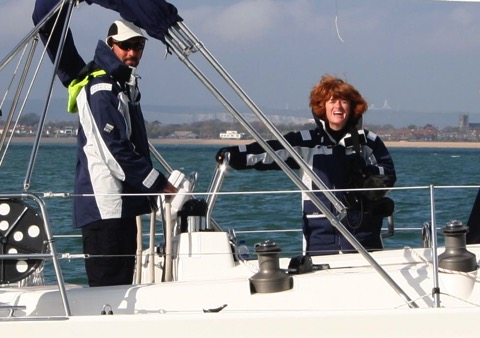
Sheryl having way too much fun!! (Photo by Yvette Jordan, SY M’LADY)
Bigger Stronger Faster
Of course one of the big advantages of a longer boat is a longer waterline which (on similar boats) should equal higher speeds. We have found this to be the case. The 49 can make 8 knots under power and so far hit 9 under sail. I know she can do more!
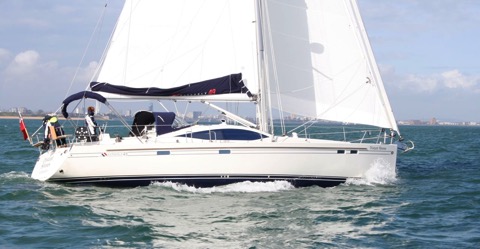
Distant Shores II sailing in the Solent (Photo by Yvette Jordan, SY M’LADY)
Comfortable Motion
The longer waterline also means less pitching and a smoother motion. We have not yet been in big seas with her but at least in moderate seas she shows the waterline length plus extremely deep keel makes for a very steady ride. (she draws 10 feet!!) Motoring out the Chichester Harbour entrance with swell against the out-flowing tide she cruised right through. Next to us were a contessa 26 and another 30 footer. The two smaller waterline boats were pitching quite a lot - showing their keel and burying their bows. A 42 footer was coming along as well and they were more similar to us - cutting through with minimal pitching. Waterline pays big dividends in comfort!
Sailing Like a Dinghy!
The day that really put my mind at ease about the bigger boat... we took out two local friends who are top-class dinghy sailors. Elizabeth and Mimie have sailed in Chichester Harbour all their lives and know every inch of the place. (They have plenty of experience cruising around the world in keel boats as well). It was a breezy day and we had the self-tacker and one reef in the main. I let them take the boat as I filmed. You can see the grins as they steered Distant Shores II around the harbour!
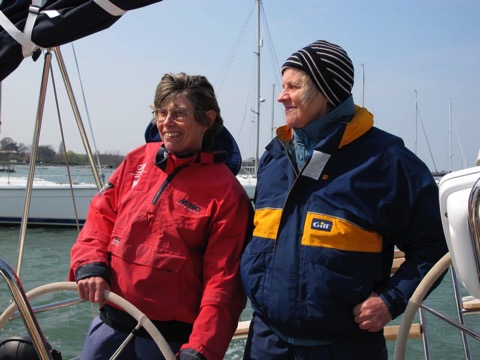
You can also see how close we are to the other boats. Their verdict was she handles great!! And to top off a perfect day we took her up to the head of the creek at high tide and then at low tide she was beached right in front of the pub!! The Crown and Anchor for dinner!
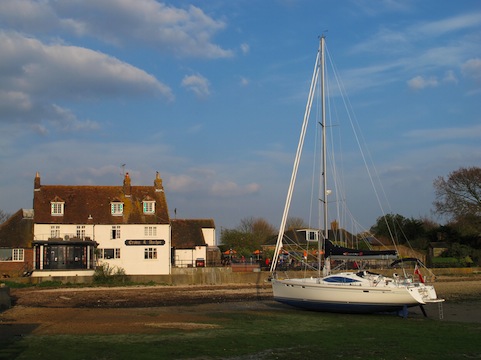
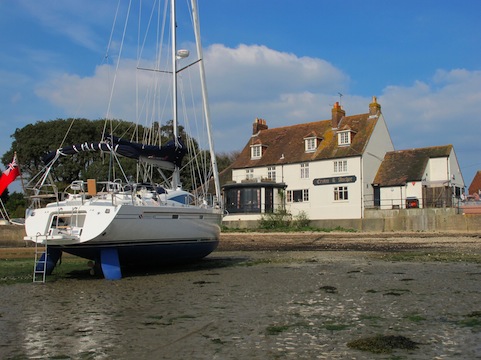
We sailed most of the way up to here at high tide.
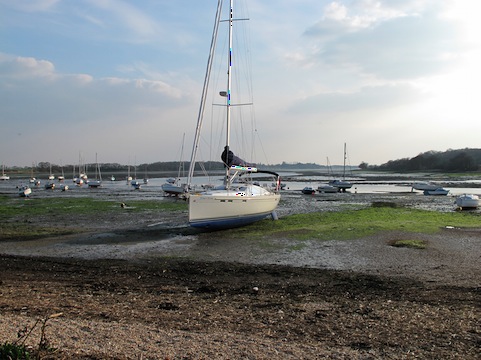
With the tide gone there is just a shallow creek left.
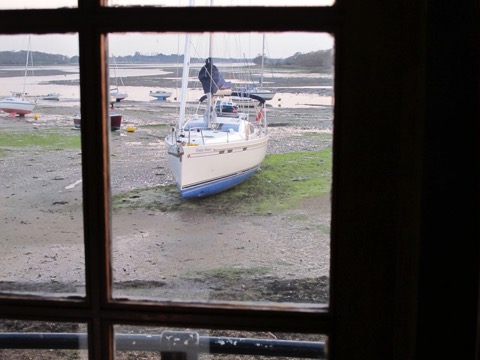
Heres the view from our table in the Crown and Anchor
Plan your passages around the world with us aboard Distant Shores

Order the Super Pack on DVD and get Season 1-10 Downloadable.
Down in the Mud
02/04/10 13:06
Our first time to put the new 49 on the ground - or in this case the mud. This is the immensely cute town of Bosham (pronounced bozzam) with its’ 1000 year old church down by the quayside. We came in at the noon high tide and stayed until the next noon. Tides here are much higher than we are used to at up to 5.2 meters! At low tide the whole of Bosham is surrounded by mud flats. All the sea is missing!
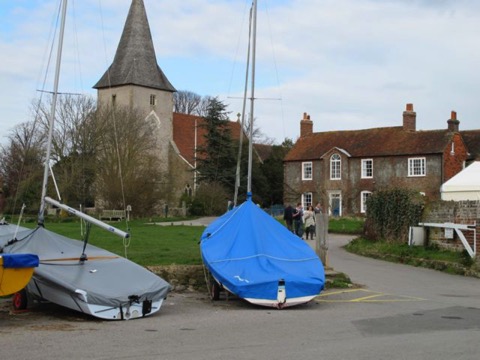
Here is the scene by 4-5 in the afternoon. All the water is gone and we have sunk down onto the mud. We were careful to tie so we could fall without straining our mooring lines. Long lines are good here. In this case we didn’t fall very far since the we landed on the mud - although the tide fell 4 meters we only fell a bit less than 2 so it was easier to tie!
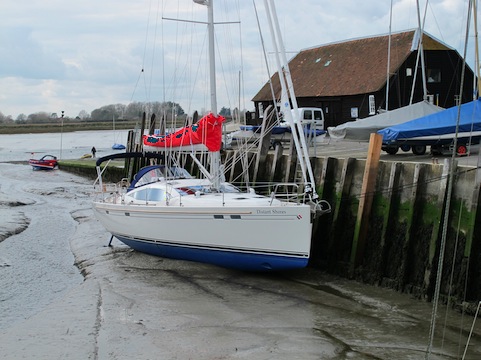
If you want to do work on the bottom you can use the drying grid they have installed here. The boat behind us is a 42 footer with over 6 foot draft. They had just a 1 hour window where the tide was high enough to allow them to come in. Then they tied up to the quay and the tide ran out. This meant a 3-4 hour period when they could get down and work on the bottom before the tide came back in. Bargain haulout!
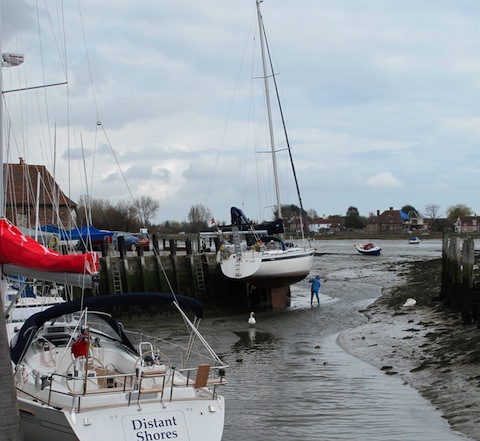
Note their boat is leaning slightly toward the quay. This is important so she just rests against the quay and her fenders. They hung a bucket off the end of the boom swung out over the quay and moved a few other heavy items that side. If you don’t do this you might end up falling away from the quay and placing tremendous strain on the docklines (or worse - falling right over!!)
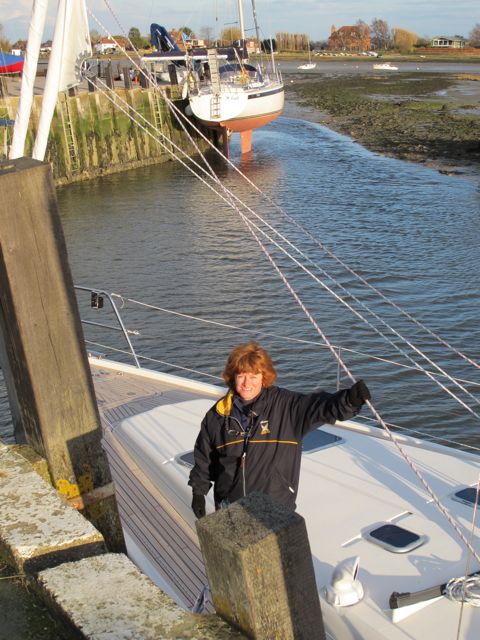
How-to Hints for drying out

Here is the scene by 4-5 in the afternoon. All the water is gone and we have sunk down onto the mud. We were careful to tie so we could fall without straining our mooring lines. Long lines are good here. In this case we didn’t fall very far since the we landed on the mud - although the tide fell 4 meters we only fell a bit less than 2 so it was easier to tie!

If you want to do work on the bottom you can use the drying grid they have installed here. The boat behind us is a 42 footer with over 6 foot draft. They had just a 1 hour window where the tide was high enough to allow them to come in. Then they tied up to the quay and the tide ran out. This meant a 3-4 hour period when they could get down and work on the bottom before the tide came back in. Bargain haulout!

Note their boat is leaning slightly toward the quay. This is important so she just rests against the quay and her fenders. They hung a bucket off the end of the boom swung out over the quay and moved a few other heavy items that side. If you don’t do this you might end up falling away from the quay and placing tremendous strain on the docklines (or worse - falling right over!!)

How-to Hints for drying out
- Check in advance that the area is going to be ok. If you have a keel boat you probably need a purpose-built drying grid since it needs a solid base to stand on and walk around underneath to work.The harbourmaster will have more info and recommendations. In our case we just need to find out if there is anything we don’t want to settle down onto.
- Tie up to account for the tides.
- Check that future tides will allow you to get off again! Read over the tables carefully
- Close the thruhulls before settling down on the mud. Especially intakes such as the engine, and head water intakes if these will be in the mud. We don’t want mud forced up into them. Remember to open them before motoring off :-)
- If you plan to stay more than 1 tide you might check it out the second time you settle down to the ground incase something has changed. This is especially important if you are a keelboat drying on the grid since you need to make certain you will rest against the quay properly.
Moulding the hull
17/06/09 08:06
Hi from the Bahamas - just a quick note as we are filming today in Harbour Island Eleuthera.
Here are a couple of shots of the new boat being moulded in the factory. Note the first part of the lay-up is done with the hull in two separate pieces which allows easier access and allows the hull pieces to be turned on their sides as you see here. So the port side of the boat is on the right and the starboard half of the hull is on the left
Note also that the upper part in the photo is greenish. This is actually the mould itself we are seeing with just a thin gelcoat applied. Northshore use a clear gelcoat as an osmosis shield as part of their Nordseal barrier system. So the area in green is below the waterline.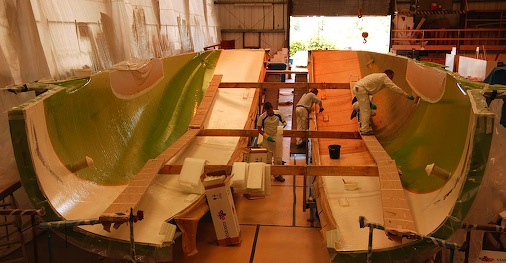
More laminate applied as the process continues. You can also see the core above the waterline being applied with vacuum bags (which is on the bottom of the picture as the hull pieces are on their sides.
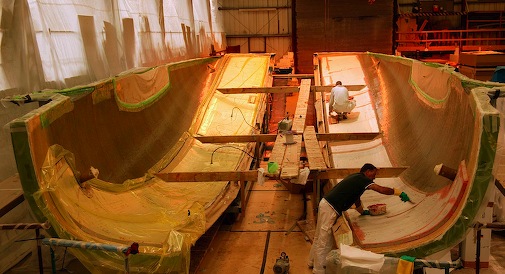
Now here are a couple of picture from the lovely Bahamas where we are currently filming on location for the Distant Shores TV series. Once again on this trip we are amazed that these islands aren't more visited. They are surely the best cruising area available to boaters on America's East Coast. The shallow water does scare some people off, but you can learn to handle it even with deeper draft boats (up to 6 feet draft is possible). But throughout the islands people are jealous of our less than 3 foot draft. Even the new 49 will draw less than 3 feet with the keel pulled up.
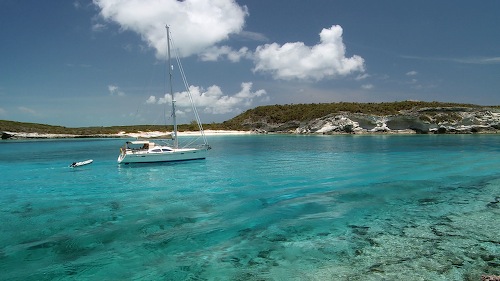
A number of the routes and anchorages we have been in the past month have only been accessible since we were shallow and also could dry out. More on the keel and drying out/bahamas strategies in further blogs. Now off filming...
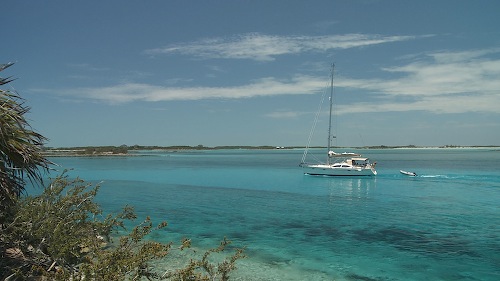
Here are a couple of shots of the new boat being moulded in the factory. Note the first part of the lay-up is done with the hull in two separate pieces which allows easier access and allows the hull pieces to be turned on their sides as you see here. So the port side of the boat is on the right and the starboard half of the hull is on the left
Note also that the upper part in the photo is greenish. This is actually the mould itself we are seeing with just a thin gelcoat applied. Northshore use a clear gelcoat as an osmosis shield as part of their Nordseal barrier system. So the area in green is below the waterline.

More laminate applied as the process continues. You can also see the core above the waterline being applied with vacuum bags (which is on the bottom of the picture as the hull pieces are on their sides.

Now here are a couple of picture from the lovely Bahamas where we are currently filming on location for the Distant Shores TV series. Once again on this trip we are amazed that these islands aren't more visited. They are surely the best cruising area available to boaters on America's East Coast. The shallow water does scare some people off, but you can learn to handle it even with deeper draft boats (up to 6 feet draft is possible). But throughout the islands people are jealous of our less than 3 foot draft. Even the new 49 will draw less than 3 feet with the keel pulled up.

A number of the routes and anchorages we have been in the past month have only been accessible since we were shallow and also could dry out. More on the keel and drying out/bahamas strategies in further blogs. Now off filming...

Revisiting the Bahamas - are they ruined?
31/07/08 06:58
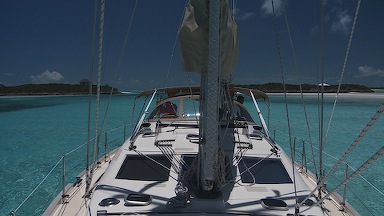 Here is a brief overview of our experience in the Bahamas. For years I had dreamed of getting WAY off the beaten path and really exploring in the Bahamas. Now we have done it and it was better than I imagined. Why?
Here is a brief overview of our experience in the Bahamas. For years I had dreamed of getting WAY off the beaten path and really exploring in the Bahamas. Now we have done it and it was better than I imagined. Why?Returning can be difficult. You have a perfect image of a place and when you go back years later it has changed. Before you know it you are heard to say "You think its nice here now - you should have seen it 15 years ago!! Now its been ruined". We have heard this more times than I can count. Either your favourite restaurant has closed, prices have risen or maybe your rose coloured glasses have slipped a bit. I was really worried before we returned to the Bahamas since our last visit was in 1996 - and I was concerned that I would be caught saying "this place has been ruined".
Well, I am happy to report we were able to return and I have not said that!!!!
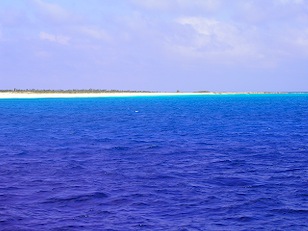
Of course things have changed in 12 years... but many of those changes are for the good, at least from my perspective.
Communications - Here's a big improvement. We remember waiting in line at the Telephone Office (BATELCO) to make a call. It was inconvenient and expensive. This time we walked into the BATELCO Office in tiny remote Mayaguana, and walked out 10 minutes later with a GSM chgip for our Euro phone. Voila - instant reasonable communications throughout the islands. Good coverage and fair prices. Plan on taking an open GSM phone with you. Their service is quite good, especially considering the wide area they have to cover. We had service in most areas. On top of that we had wifi internet access! So we had real communications with back home and it was affordable.
Crowding - I had been worried the Bahamas would be more crowded than before - but it didn't seem so. Certainly more boats seemed to be in some of the popular areas, but not much. And getting further off the beaten path meant we easily had whole islands just to ourselves.
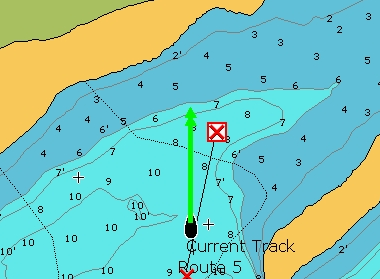
Money - Here's one area I was expecting an improvement but didn't find one. Banks and bank machines have expanded only slightly, and in the remote islands there are still many islands where you can't get money from a bank since there isn't one on the island. Just plan ahead and bring cash to the islands. You will regret if you don't and have the opportunity for super great local cooking but are hoarding your cash until the next Cash Machine.
Pick the Season - We still feel the nicest season to cruise the Bahamas is the spring. We arrived in May just after many cruisers had left to head north. The weather in April May and June is often the best of the year. We enjoyed a fabulous cruise with lovely breezes and just one front. Perfect for exploring the out islands! If you get down as many do, for the winter, don't head out to soon in the spring. Its often the best time!
Its not to late - the Bahamas haven't been ruined. Maybe we'll see you down there on our next visit! If you see us please come and say hi to us on "Distant Shores"!
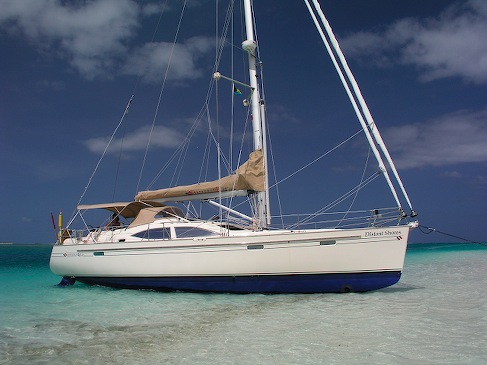
Shallow Water Dreamboat!
01/06/08 15:52
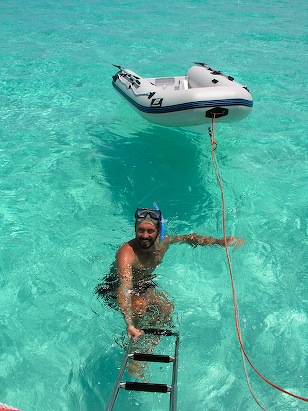
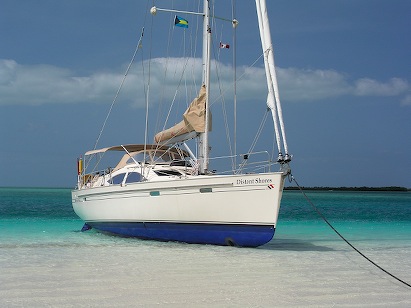
We have been able to beach the boat for the first time and dry out on the sand. This is a feature of the Southerly and we found we could explore areas where other boats can't go. There are so many shallow islands without good all-weather anchorages (for deeper boats) but were great for us. We have been lifting the keel up to about 4 and a half foot draft and then venturing of the beaten track.If it is really shallow we can set the draft as low as 3 foot.
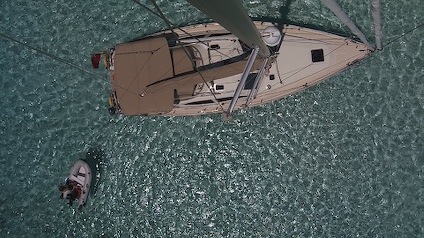
To beach the boat we have been looking around for a nice spot, then running up on the beach on a falling tide. Just be sure not to do it at the very highest in case you can't get off on the next high. This is apparently called being "neaped" by Robert - our Northshore expert. So, we pick a nice beach - protected from swells and with no rocks on the bottom - and run up to the beach at near high tide. We prepare our Fortress stern anchor and line on the aft swim platform and drop it 75 feet away as we head in. We head for the beach at about 2-3 knots and gently fetch up on the sand. Then I walk the anchor out forward to stop us drifting away if we want to stay for the night. In this case we will stay for 2 low tides and float off again in the next high.
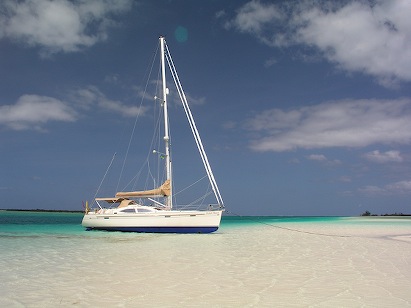
So the verdict after a 6 week dream cruise in the Bahamas is that this is our perfect Bahamas boat!
More new boat pix!! and the Keel!!
28/07/07 13:25
The New Boat and her keel!!
Here are some images from the Northshore yard in Itchenor. The new boat has just arrived from the moulding shop and is ready to be fitted out. There are also some pictures here of her lifting keel as that will be one of the first projects - to fit the keel in place. I though this would be a good time to look at the keel system in general since the keel and the Southerly's shallow draft abilities are a big part of the reason we chose her for our next boat!
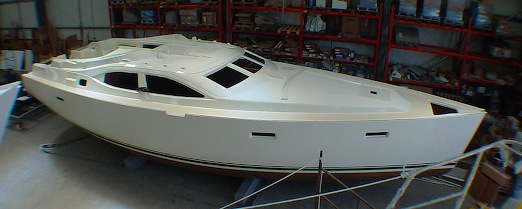
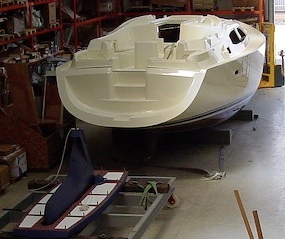 Keel System
Keel System
Here the keel is prepped and ready to go into the boat. The keel system consists of a massive grounding plate that bolts into the bottom of the boat. This plate weighs 2100Kg (4600 pounds) which is quite a bit more than our car. In the picture you can see the swinging keel itself in the raised position. It weighs another 1570Kg (3500 pounds) which is about the weight of a BMW 525. So when you swing the keel down you are basically hanging the weight of a respectable car down for added performance. With 9 foot draft this boat sails well to windward! Its one of the advantages of a swinging keel that the designer could go as low as he wanted for good performance.
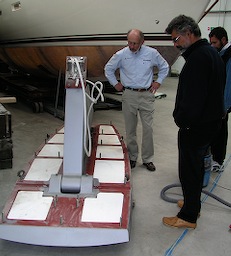 Here is a shot of the keel close up. This is a massively strong system that Northshore have refined since they started building swing-keel boats more than 20 years ago. You can see the widely spaced bolt pattern that connects the keel to the reinforced inset in the hull. One thing I specially like about the builder is their British engineering! Good and solid!
Here is a shot of the keel close up. This is a massively strong system that Northshore have refined since they started building swing-keel boats more than 20 years ago. You can see the widely spaced bolt pattern that connects the keel to the reinforced inset in the hull. One thing I specially like about the builder is their British engineering! Good and solid!
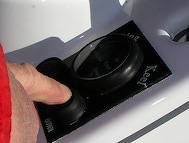 Raising and lowering the keel is done by a hydraulic system. There is an electric pump that runs the hydraulic system and it is remotely controlled from the helm. Just above the buttons is a series of LEDs that show how high the keel is. There is also an emergency handle to be used in case the electric system fails.
Raising and lowering the keel is done by a hydraulic system. There is an electric pump that runs the hydraulic system and it is remotely controlled from the helm. Just above the buttons is a series of LEDs that show how high the keel is. There is also an emergency handle to be used in case the electric system fails.
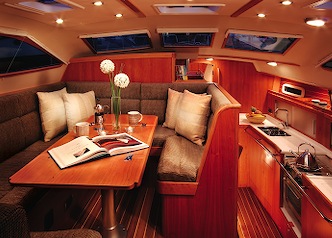 Boat Design for a Swing Keel
Boat Design for a Swing Keel
One of the toughest aspect of designing a good swinging or lifting keel boat is what to do with the keel when it comes up! It has to go somewhere and many designers have had trouble with this. We have been on lifting keel boats where the keel case divides the whole saloon. Very inconvenient. But Northshore have come up with an ingenious design for the 42 that hides the keel just under the starboard side of the raised saloon. The raised saloon has great views while sitting there, and I doubt anyone coming on board at the boat show would even guess there was a keel the weight of a BMW retracted under their seat. Here is a picture of the saloon - the keel retracts under the seat on the centreline of the boat. Very clever design.
Why go to all this bother?
Well this image of a Bahamas Bank says it all. There are so many unspoiled anchorages we will be able to get to with a shallow keel - and the Bahamas is arguably the finest cruising ground within easy reach of North American East Coast sailors. We have sailed there 4 different cruises and have fallen in love with the place. There are whole island groups that are hard to visit with a deep draft yacht. We are going back with the Southerly!! (see below)
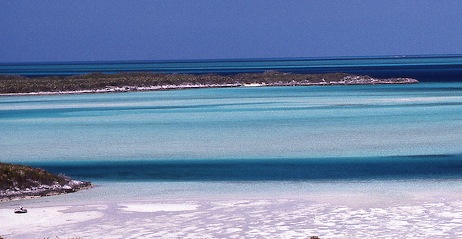
Shallow Draft
Many places in the world are easy to navigate if you have a shallower boat. The Trent-Severn Waterway in Canada is limited to 5 feet. Ditto the Midi Canal in France. Many places in the US Intra-Coastal Waterway are shoaling up around the inlets. Boats that draw more than 5 feet are deeper than the average so dredging often doesn't occur until that number is reached and the problem starts to affect the majority of boats.
But there is more to shallow draft cruising. Some powerboats draw just 3-4 feet but can't afford to run aground! By this I mean they have props hanging down being the lowest point. So if they hit it is likely expensive. With Two-Step we could often poke slowly into places that were just 6 feet deep since when we touched the bottom it didn't matter. Just our keel would touch and we would then reverse off again. The new boat is the best of both worlds - it draws just 3 feet but can also afford to run aground since it has the heavy keel and a grounding plate, and it protects its prop with a skeg. We will be able to poke slowly into really shallow spots.
Of course we wouldn't want to have the ability to get to shallow places and still not feel safe crossing oceans. The Southerly can do that too. Many have crossed oceans, and we are looking forward to a nice quick transatlantic passage this fall - en route to the Caribbean.
Shoal Draft Anchorages
The final advantage for the Southerly keel is the ability to dry out. It is actually one of the main reasons for the design. In the South of England and the north West of France there are many tidal anchorages. This would be a place that would be a good anchorage at high tide but would have no water at low tide. So the only kind of boat that can anchor there would need to be able to rest down on the bottom at low tide. In Two-Step we would have not been able to anchor there since the keel would cause the boat to heel further and further as the tide went down. We would finally be lying on our side. Most uncomfortable and possibly even at risk of flooding as the water came back in. With the new boat this is the perfect anchorage. And again, the Bahamas has many places like this. Comparing to Two-Step, I would imagine there are as many as double the Bahamian anchorages available for the Southerly as for Two-Step. Similar in the Chesapeake and Atlantic France.
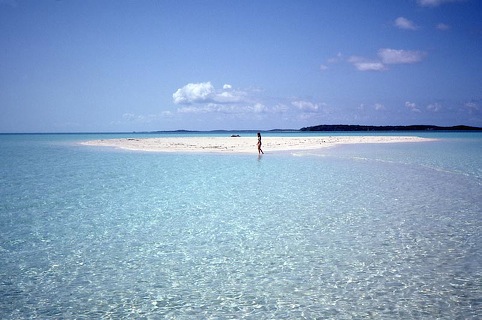
Here are some images from the Northshore yard in Itchenor. The new boat has just arrived from the moulding shop and is ready to be fitted out. There are also some pictures here of her lifting keel as that will be one of the first projects - to fit the keel in place. I though this would be a good time to look at the keel system in general since the keel and the Southerly's shallow draft abilities are a big part of the reason we chose her for our next boat!

 Keel System
Keel SystemHere the keel is prepped and ready to go into the boat. The keel system consists of a massive grounding plate that bolts into the bottom of the boat. This plate weighs 2100Kg (4600 pounds) which is quite a bit more than our car. In the picture you can see the swinging keel itself in the raised position. It weighs another 1570Kg (3500 pounds) which is about the weight of a BMW 525. So when you swing the keel down you are basically hanging the weight of a respectable car down for added performance. With 9 foot draft this boat sails well to windward! Its one of the advantages of a swinging keel that the designer could go as low as he wanted for good performance.



One of the toughest aspect of designing a good swinging or lifting keel boat is what to do with the keel when it comes up! It has to go somewhere and many designers have had trouble with this. We have been on lifting keel boats where the keel case divides the whole saloon. Very inconvenient. But Northshore have come up with an ingenious design for the 42 that hides the keel just under the starboard side of the raised saloon. The raised saloon has great views while sitting there, and I doubt anyone coming on board at the boat show would even guess there was a keel the weight of a BMW retracted under their seat. Here is a picture of the saloon - the keel retracts under the seat on the centreline of the boat. Very clever design.
Why go to all this bother?
Well this image of a Bahamas Bank says it all. There are so many unspoiled anchorages we will be able to get to with a shallow keel - and the Bahamas is arguably the finest cruising ground within easy reach of North American East Coast sailors. We have sailed there 4 different cruises and have fallen in love with the place. There are whole island groups that are hard to visit with a deep draft yacht. We are going back with the Southerly!! (see below)

Shallow Draft
Many places in the world are easy to navigate if you have a shallower boat. The Trent-Severn Waterway in Canada is limited to 5 feet. Ditto the Midi Canal in France. Many places in the US Intra-Coastal Waterway are shoaling up around the inlets. Boats that draw more than 5 feet are deeper than the average so dredging often doesn't occur until that number is reached and the problem starts to affect the majority of boats.
But there is more to shallow draft cruising. Some powerboats draw just 3-4 feet but can't afford to run aground! By this I mean they have props hanging down being the lowest point. So if they hit it is likely expensive. With Two-Step we could often poke slowly into places that were just 6 feet deep since when we touched the bottom it didn't matter. Just our keel would touch and we would then reverse off again. The new boat is the best of both worlds - it draws just 3 feet but can also afford to run aground since it has the heavy keel and a grounding plate, and it protects its prop with a skeg. We will be able to poke slowly into really shallow spots.
Of course we wouldn't want to have the ability to get to shallow places and still not feel safe crossing oceans. The Southerly can do that too. Many have crossed oceans, and we are looking forward to a nice quick transatlantic passage this fall - en route to the Caribbean.
Shoal Draft Anchorages
The final advantage for the Southerly keel is the ability to dry out. It is actually one of the main reasons for the design. In the South of England and the north West of France there are many tidal anchorages. This would be a place that would be a good anchorage at high tide but would have no water at low tide. So the only kind of boat that can anchor there would need to be able to rest down on the bottom at low tide. In Two-Step we would have not been able to anchor there since the keel would cause the boat to heel further and further as the tide went down. We would finally be lying on our side. Most uncomfortable and possibly even at risk of flooding as the water came back in. With the new boat this is the perfect anchorage. And again, the Bahamas has many places like this. Comparing to Two-Step, I would imagine there are as many as double the Bahamian anchorages available for the Southerly as for Two-Step. Similar in the Chesapeake and Atlantic France.

Selling Two-Step and buying another boat!
30/12/06 08:59
Oh boy this is getting to the tough part! For months I have been dreaming of the new boat - what will she look like, feel like etc. But now we are getting around to actually selling Two-Step and its proving tougher than I had thought. Well we did build her ourselves, and for all the years we have sailed her we have always been making improvements to her and looking after her as she has looked after us on numerous ocean miles. She has been a good boat for us and now I have been making up a website to sell her!?!?
Anyway, for anyone interested, I am putting together a page with shots and equipment lists etc. She is a very full featured boat - certainly ready to cross oceans. She may be right for you!
What to buy next?
So now I am zeroing in on the next Two-Step and I keep coming back to wanting a shallow draft cruiser to explore further...
Shallow draft and the Cruising Sailor
Why am I so keen to get a boat that draws less than 4 feet?
Anchorages, canals, rivers, Bahamas!! A big part of the reason we cruise is to explore the places we sail to. And there are many waterways and whole cruising grounds we are excluded from with our 6-foot draft. Although we are almost average compared to sailboats, we are quite deep compared to boats in general. All small craft and almost all power boats less than 70 feet long draw less than 5 feet. Many only draw 3 or 4. So there are many waterways designed for these boats. In more than one occasion we have sat aground in the middle of the US intracoastal waterway. Silting up from the planned 8 or 9 foot depths is only a problem when it affects enough boats I guess. Once we sat directly between the red and green markers of the channel so everyone could see we were squarely in the right place. The Florida Marine Police even came up and complained that we were sitting in the middle of a navigable waterway (not SO navigable I would say). But my point is that as we sat there a large number of craft right up to a 60 foot motor yacht sailed happily around us. We were the deepest boat for those 2 hours. Having a shoal draft would also have let us sail on down through the Florida Keys. The Bahamas is another whole cruising area. Anyone who has visited this cruising paradise will not only tell you how lovely it is but also how it would help to have a shallow draft to see more of it. There are whole island groups out of bounds to our 6 feet. Here 3-feet would be perfect!! Then there are the European canals – much easier to handle with shallow draft. So many places we could visit. Even the canal running up to our home base in Canada just north of Toronto requires less than 5-foot draft.
Isn't it less seaworthy to have shoal draft?
Certainly there have been very seaworthy boats that managed to have a shallow draft by putting the weight of the keel all along the bottom instead of concentrating it in a big bulb. Joshua Slocum's Spray only drew roughly 4 feet. But these boats tend to be slower than modern sailors are willing to accept. They were made within the limits of the materials. Wood just didn't allow the more interesting shapes of modern boats to be made strongly. So if you accept our modern quicker hulls with lower wetted surface area and beamy hulls for more accommodation, you are going to need to put some ballast fairly low to keep them safe. But remember that modern boats are also much lighter than previous craft of the same length. So it is possible to get a good stable boat by concentrating a lot of weight deep in the hull. Obviously you could get away with less weight if you could hang it lower but it can be done.
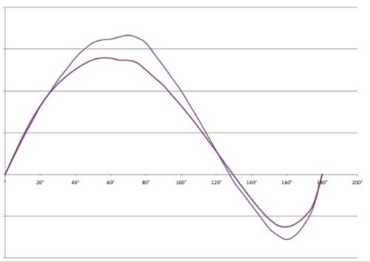
How do you measure whether the stability is sufficient?
A stability curve can be generated for a particular model of boat. The line basically shows if the boat wants to stay upright (and we all like boats that like to stay upright!!).
The simplest way to look at the stability curve of a sailboat is to see the how much of the curve is above the line and how much is below. The point where the curve crosses the line is also important and is known as the angle of vanishing stability. At risk of oversimplifying, the higher this number, the safer the boat.
What are the main factors affecting stability?
Basically the stability as measured by the curve is determined by the distribution of weight in the boat and the form of the hull and deckhouse. So a boat with a mediocre stability such as a canoe, could be improved by adding some weight in a keel hung 1 meter down, and by building a lightweight deck to stop water coming in when heeled past 30 degrees. Any boat will be improved for (stability purposes) by removing unnecessary weight above the centre of gravity. In fact this is a good reason not to take your collected 30 years of National Geographic Magazines and store them up on the bulkhead. Similarly jugs of water and fuel lashed on deck and the outboard motor up on a bracket, all add to the top heaviness and reduce the stability of a boat.
What about a very deep keel?
The easiest way to improve a sailboats stability and also its sailing characteristics is to concentrate more of the boat's weight lower in the keel. The racing community have embraced this concept! Todays racers have bulbs suspended on a winglike blade and may draw 3 or 4 meters. The newest use hydraulics to swing the keel from side to side to improve the righting moment even more dramatically. For the rest of us cruising in the real world where there are shoals, lobster pots and slips with limited depth these keels are impractical but they are certainly a trend in the racing world and show some interesting potential for cruising boats if the ideas weren't quite so radical.
How about a keel that swings down for offshore work and lifts up for shallow draft?
This isn't a new idea but there have been difficulties in the past. A boat made of wood needs a large area to provide the strength to attach a keel and distribute the tremendous loads of a heavy keel where it would slide or swing into the hull. Similarly fiberglass would need great reinforcement but would be easier to accomplish. And steel or aluminum have easily got the strength to support a well designed movable keel. Now modern racing boats are making canting keels by taking advantage of modern hi strength materials. So although most cruisers will shake their heads at the radical canting bulb keels that swing many tons out to the side of the new crop of maxi-yachts, there is no denying that racers are paving the way for cruisers to follow by showing that keels don't just have to be fixed to the bottom of a sailboat.
What is out there for cruisers?
There are a few cruising boats right now that have shallow draft and have solved the keel problem in interesting ways.
Traditional boat with a centreboard – Classic yachts like the Bermuda 40 have reduced the keel depth somewhat, and added a centreboard to reduce leeway when beating. Simplest to build and proven over years they do reduce the draft but not by much. And since the centreboard usually doesn't contribute much to the ballast, these designs do not offer an increase in stability.
Centreboard in a modern hull shape. French builders Garcia and Alubat (builders of the Ovni series – which incidentally means U.F.O. in french since they do look a bit wild!) have built a number of models in aluminum that have a modern beam and waterline but no built in keel at all. The ballast is concentrated in the bottom of the hull itself, and the centreboard keel that swings down is almost neutral – designed to reduce leeway and allow the boats to go to windward but not add to the righting moment. These boats tend to be heavier than conventional designs since more ballast is required to make up for none of it being lower than their typically 1 meter draft. But these boats are popular with sailors interested in shallow water, and have also done many offshore passages. Jimmy Cornell sailed an Ovni 43 for years and now has another aluminum shallow draft sailboat custom made by Garcia.
Lifting keel daggerboard in a modern hull – European design firm Van De Stadt have done a number of models that have a bulb on a daggerboard where a substantial amount of ballast is hung down to a depth that makes their modern hull shape virtually equivalent to a modern deep keel boat. At sea the boat would perform like a modern racer/cruiser, but by hydraulically raising the keel the draft is reduced by up to 1 meter as you sail into your marina! Disadvantages include the possibility of jamming the daggerboard if you run aground when it is down, and the fact that stability is very affected by the keel. So if you have the keel up you would be careful not to overpower the boat with full sails. In practice you could just remember to reduce sail before raising the keel.
Modern hull with ballast in a centreboard – British-built Southerlies have an interesting system where a deep centreboard comprises 35 percent of the ballast package, and the remaining is in a large plate in the deepest part of the hull. The boats are fibreglass but instead of worrying about how to attach the centreboard securely to the glass hull, Southerlies use the massive ballast plate to fashion a sturdy attachment point in cast iron. That way the loads of the ballast attachment to the glass hull are distributed over the size of the ballast plate. With a heritage of the south of England, the design is meant to be able to dry out by resting on the ballast plate, and she can also deal with running aground since the centreboard is designed to kick up without causing harm. Since the heavy centreboard affects the stability quite a bit, the boat actually has two stability curves. Stability is good even with the board up, but there is greater righting moment with the board down, and of course she will make much less leeway. Southerly seems to me to have the most promising mix of shallow draft, seaworthiness and not too much technology to get in the way. But how do they deal with the rudder when they go aground and how do they lift that heavy centreboard. I am going to investigate further!
Anyway, for anyone interested, I am putting together a page with shots and equipment lists etc. She is a very full featured boat - certainly ready to cross oceans. She may be right for you!
What to buy next?
So now I am zeroing in on the next Two-Step and I keep coming back to wanting a shallow draft cruiser to explore further...
Shallow draft and the Cruising Sailor
Why am I so keen to get a boat that draws less than 4 feet?
Anchorages, canals, rivers, Bahamas!! A big part of the reason we cruise is to explore the places we sail to. And there are many waterways and whole cruising grounds we are excluded from with our 6-foot draft. Although we are almost average compared to sailboats, we are quite deep compared to boats in general. All small craft and almost all power boats less than 70 feet long draw less than 5 feet. Many only draw 3 or 4. So there are many waterways designed for these boats. In more than one occasion we have sat aground in the middle of the US intracoastal waterway. Silting up from the planned 8 or 9 foot depths is only a problem when it affects enough boats I guess. Once we sat directly between the red and green markers of the channel so everyone could see we were squarely in the right place. The Florida Marine Police even came up and complained that we were sitting in the middle of a navigable waterway (not SO navigable I would say). But my point is that as we sat there a large number of craft right up to a 60 foot motor yacht sailed happily around us. We were the deepest boat for those 2 hours. Having a shoal draft would also have let us sail on down through the Florida Keys. The Bahamas is another whole cruising area. Anyone who has visited this cruising paradise will not only tell you how lovely it is but also how it would help to have a shallow draft to see more of it. There are whole island groups out of bounds to our 6 feet. Here 3-feet would be perfect!! Then there are the European canals – much easier to handle with shallow draft. So many places we could visit. Even the canal running up to our home base in Canada just north of Toronto requires less than 5-foot draft.
Isn't it less seaworthy to have shoal draft?
Certainly there have been very seaworthy boats that managed to have a shallow draft by putting the weight of the keel all along the bottom instead of concentrating it in a big bulb. Joshua Slocum's Spray only drew roughly 4 feet. But these boats tend to be slower than modern sailors are willing to accept. They were made within the limits of the materials. Wood just didn't allow the more interesting shapes of modern boats to be made strongly. So if you accept our modern quicker hulls with lower wetted surface area and beamy hulls for more accommodation, you are going to need to put some ballast fairly low to keep them safe. But remember that modern boats are also much lighter than previous craft of the same length. So it is possible to get a good stable boat by concentrating a lot of weight deep in the hull. Obviously you could get away with less weight if you could hang it lower but it can be done.

How do you measure whether the stability is sufficient?
A stability curve can be generated for a particular model of boat. The line basically shows if the boat wants to stay upright (and we all like boats that like to stay upright!!).
The simplest way to look at the stability curve of a sailboat is to see the how much of the curve is above the line and how much is below. The point where the curve crosses the line is also important and is known as the angle of vanishing stability. At risk of oversimplifying, the higher this number, the safer the boat.
What are the main factors affecting stability?
Basically the stability as measured by the curve is determined by the distribution of weight in the boat and the form of the hull and deckhouse. So a boat with a mediocre stability such as a canoe, could be improved by adding some weight in a keel hung 1 meter down, and by building a lightweight deck to stop water coming in when heeled past 30 degrees. Any boat will be improved for (stability purposes) by removing unnecessary weight above the centre of gravity. In fact this is a good reason not to take your collected 30 years of National Geographic Magazines and store them up on the bulkhead. Similarly jugs of water and fuel lashed on deck and the outboard motor up on a bracket, all add to the top heaviness and reduce the stability of a boat.
What about a very deep keel?
The easiest way to improve a sailboats stability and also its sailing characteristics is to concentrate more of the boat's weight lower in the keel. The racing community have embraced this concept! Todays racers have bulbs suspended on a winglike blade and may draw 3 or 4 meters. The newest use hydraulics to swing the keel from side to side to improve the righting moment even more dramatically. For the rest of us cruising in the real world where there are shoals, lobster pots and slips with limited depth these keels are impractical but they are certainly a trend in the racing world and show some interesting potential for cruising boats if the ideas weren't quite so radical.
How about a keel that swings down for offshore work and lifts up for shallow draft?
This isn't a new idea but there have been difficulties in the past. A boat made of wood needs a large area to provide the strength to attach a keel and distribute the tremendous loads of a heavy keel where it would slide or swing into the hull. Similarly fiberglass would need great reinforcement but would be easier to accomplish. And steel or aluminum have easily got the strength to support a well designed movable keel. Now modern racing boats are making canting keels by taking advantage of modern hi strength materials. So although most cruisers will shake their heads at the radical canting bulb keels that swing many tons out to the side of the new crop of maxi-yachts, there is no denying that racers are paving the way for cruisers to follow by showing that keels don't just have to be fixed to the bottom of a sailboat.
What is out there for cruisers?
There are a few cruising boats right now that have shallow draft and have solved the keel problem in interesting ways.
Traditional boat with a centreboard – Classic yachts like the Bermuda 40 have reduced the keel depth somewhat, and added a centreboard to reduce leeway when beating. Simplest to build and proven over years they do reduce the draft but not by much. And since the centreboard usually doesn't contribute much to the ballast, these designs do not offer an increase in stability.
Centreboard in a modern hull shape. French builders Garcia and Alubat (builders of the Ovni series – which incidentally means U.F.O. in french since they do look a bit wild!) have built a number of models in aluminum that have a modern beam and waterline but no built in keel at all. The ballast is concentrated in the bottom of the hull itself, and the centreboard keel that swings down is almost neutral – designed to reduce leeway and allow the boats to go to windward but not add to the righting moment. These boats tend to be heavier than conventional designs since more ballast is required to make up for none of it being lower than their typically 1 meter draft. But these boats are popular with sailors interested in shallow water, and have also done many offshore passages. Jimmy Cornell sailed an Ovni 43 for years and now has another aluminum shallow draft sailboat custom made by Garcia.
Lifting keel daggerboard in a modern hull – European design firm Van De Stadt have done a number of models that have a bulb on a daggerboard where a substantial amount of ballast is hung down to a depth that makes their modern hull shape virtually equivalent to a modern deep keel boat. At sea the boat would perform like a modern racer/cruiser, but by hydraulically raising the keel the draft is reduced by up to 1 meter as you sail into your marina! Disadvantages include the possibility of jamming the daggerboard if you run aground when it is down, and the fact that stability is very affected by the keel. So if you have the keel up you would be careful not to overpower the boat with full sails. In practice you could just remember to reduce sail before raising the keel.
Modern hull with ballast in a centreboard – British-built Southerlies have an interesting system where a deep centreboard comprises 35 percent of the ballast package, and the remaining is in a large plate in the deepest part of the hull. The boats are fibreglass but instead of worrying about how to attach the centreboard securely to the glass hull, Southerlies use the massive ballast plate to fashion a sturdy attachment point in cast iron. That way the loads of the ballast attachment to the glass hull are distributed over the size of the ballast plate. With a heritage of the south of England, the design is meant to be able to dry out by resting on the ballast plate, and she can also deal with running aground since the centreboard is designed to kick up without causing harm. Since the heavy centreboard affects the stability quite a bit, the boat actually has two stability curves. Stability is good even with the board up, but there is greater righting moment with the board down, and of course she will make much less leeway. Southerly seems to me to have the most promising mix of shallow draft, seaworthiness and not too much technology to get in the way. But how do they deal with the rudder when they go aground and how do they lift that heavy centreboard. I am going to investigate further!
UPDATE 2014
- Southerly have sadly gone out of business producing new sailboats. Luckily they built over 800 boats in all the decades they were in business so you can find one on Yachtworld :-)